Quick filters:
Poison darnel Stock Photos and Images
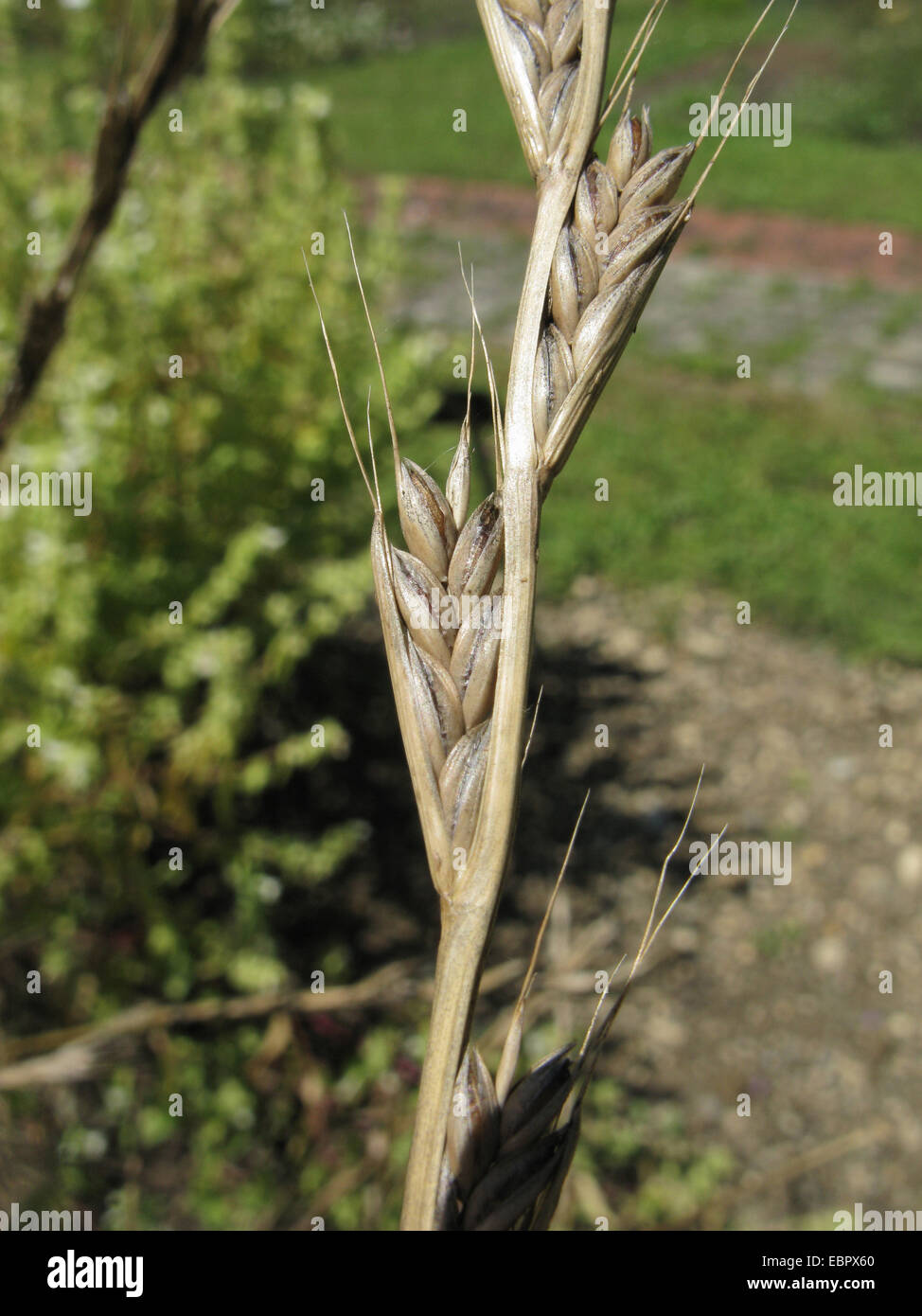 bearded darnel, poison rye-grass (Lolium temulentum), ripe spikelets, Germany Stock Photohttps://www.alamy.com/image-license-details/?v=1https://www.alamy.com/stock-photo-bearded-darnel-poison-rye-grass-lolium-temulentum-ripe-spikelets-germany-76106184.html
bearded darnel, poison rye-grass (Lolium temulentum), ripe spikelets, Germany Stock Photohttps://www.alamy.com/image-license-details/?v=1https://www.alamy.com/stock-photo-bearded-darnel-poison-rye-grass-lolium-temulentum-ripe-spikelets-germany-76106184.htmlRMEBPX60–bearded darnel, poison rye-grass (Lolium temulentum), ripe spikelets, Germany
 Lolium temulentum or Darnel or Poison darnel or Cockle, vintage engraved illustration. Dictionary of words and things - Larive a Stock Vectorhttps://www.alamy.com/image-license-details/?v=1https://www.alamy.com/stock-photo-lolium-temulentum-or-darnel-or-poison-darnel-or-cockle-vintage-engraved-84413779.html
Lolium temulentum or Darnel or Poison darnel or Cockle, vintage engraved illustration. Dictionary of words and things - Larive a Stock Vectorhttps://www.alamy.com/image-license-details/?v=1https://www.alamy.com/stock-photo-lolium-temulentum-or-darnel-or-poison-darnel-or-cockle-vintage-engraved-84413779.htmlRFEW9AHR–Lolium temulentum or Darnel or Poison darnel or Cockle, vintage engraved illustration. Dictionary of words and things - Larive a
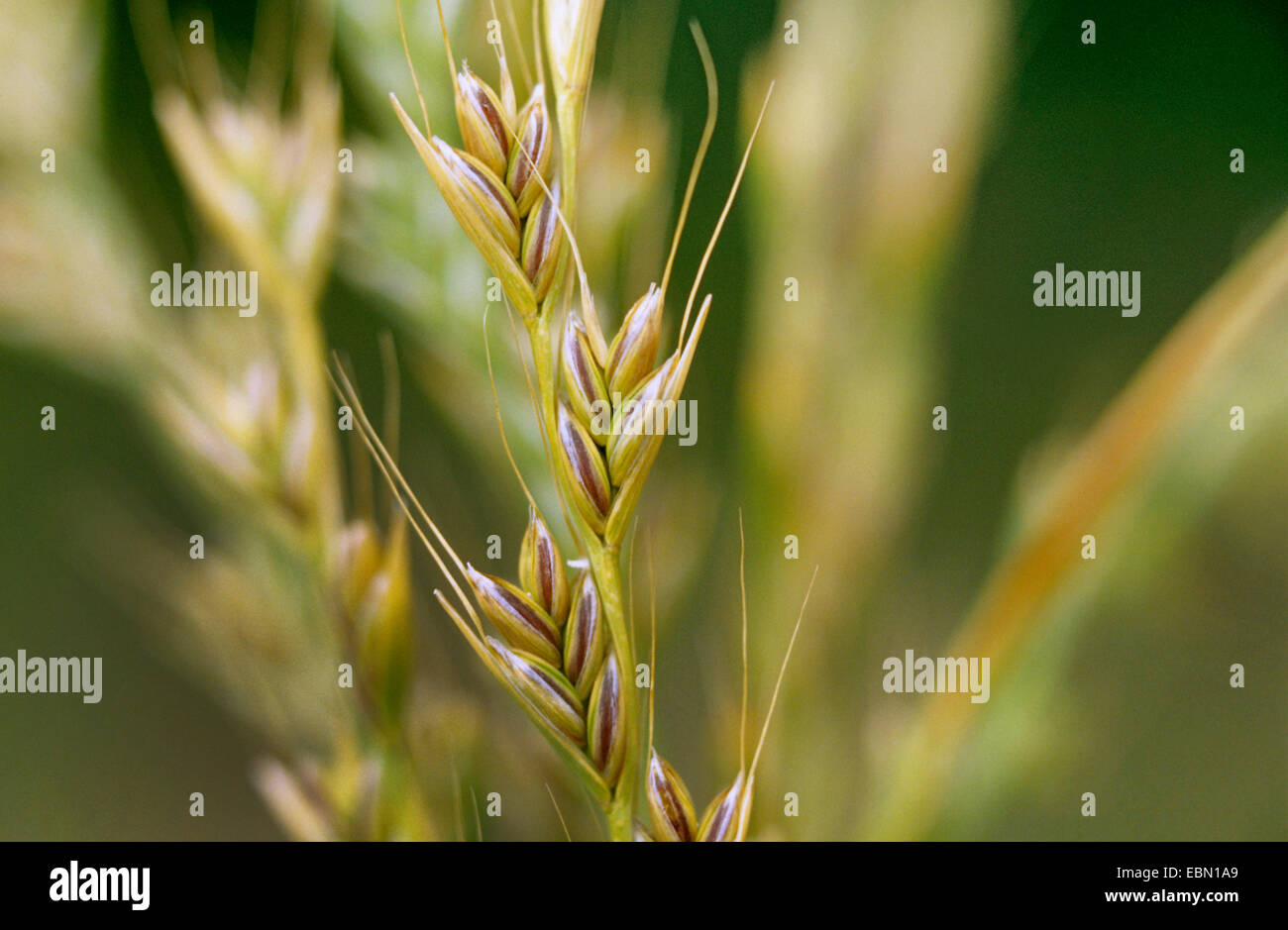 bearded darnel, poison rye-grass (Lolium temulentum), spike, Germany Stock Photohttps://www.alamy.com/image-license-details/?v=1https://www.alamy.com/stock-photo-bearded-darnel-poison-rye-grass-lolium-temulentum-spike-germany-76064753.html
bearded darnel, poison rye-grass (Lolium temulentum), spike, Germany Stock Photohttps://www.alamy.com/image-license-details/?v=1https://www.alamy.com/stock-photo-bearded-darnel-poison-rye-grass-lolium-temulentum-spike-germany-76064753.htmlRMEBN1A9–bearded darnel, poison rye-grass (Lolium temulentum), spike, Germany
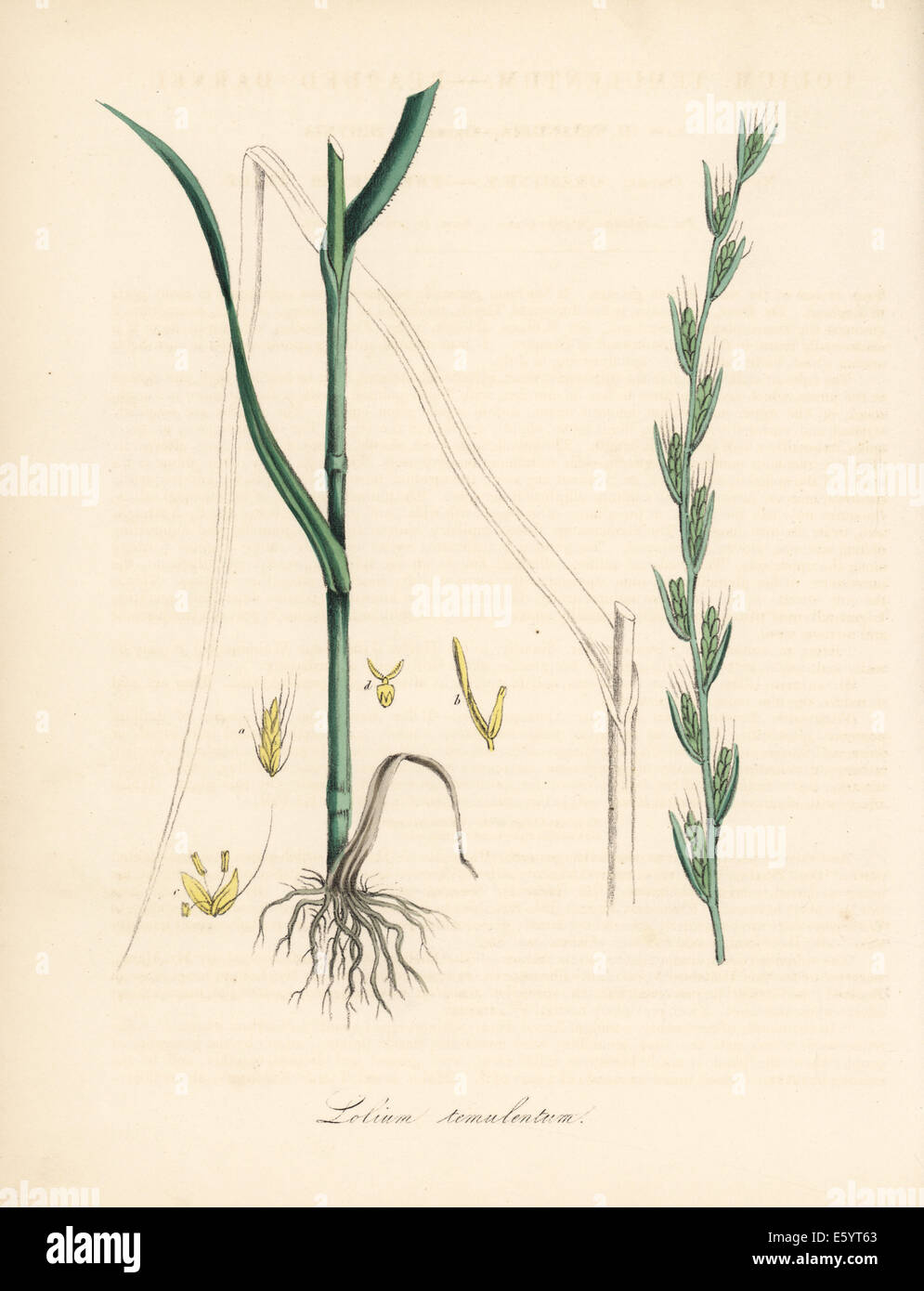 Bearded darnel or poison darnel, Lolium temulentum. Stock Photohttps://www.alamy.com/image-license-details/?v=1https://www.alamy.com/stock-photo-bearded-darnel-or-poison-darnel-lolium-temulentum-72526443.html
Bearded darnel or poison darnel, Lolium temulentum. Stock Photohttps://www.alamy.com/image-license-details/?v=1https://www.alamy.com/stock-photo-bearded-darnel-or-poison-darnel-lolium-temulentum-72526443.htmlRME5YT63–Bearded darnel or poison darnel, Lolium temulentum.
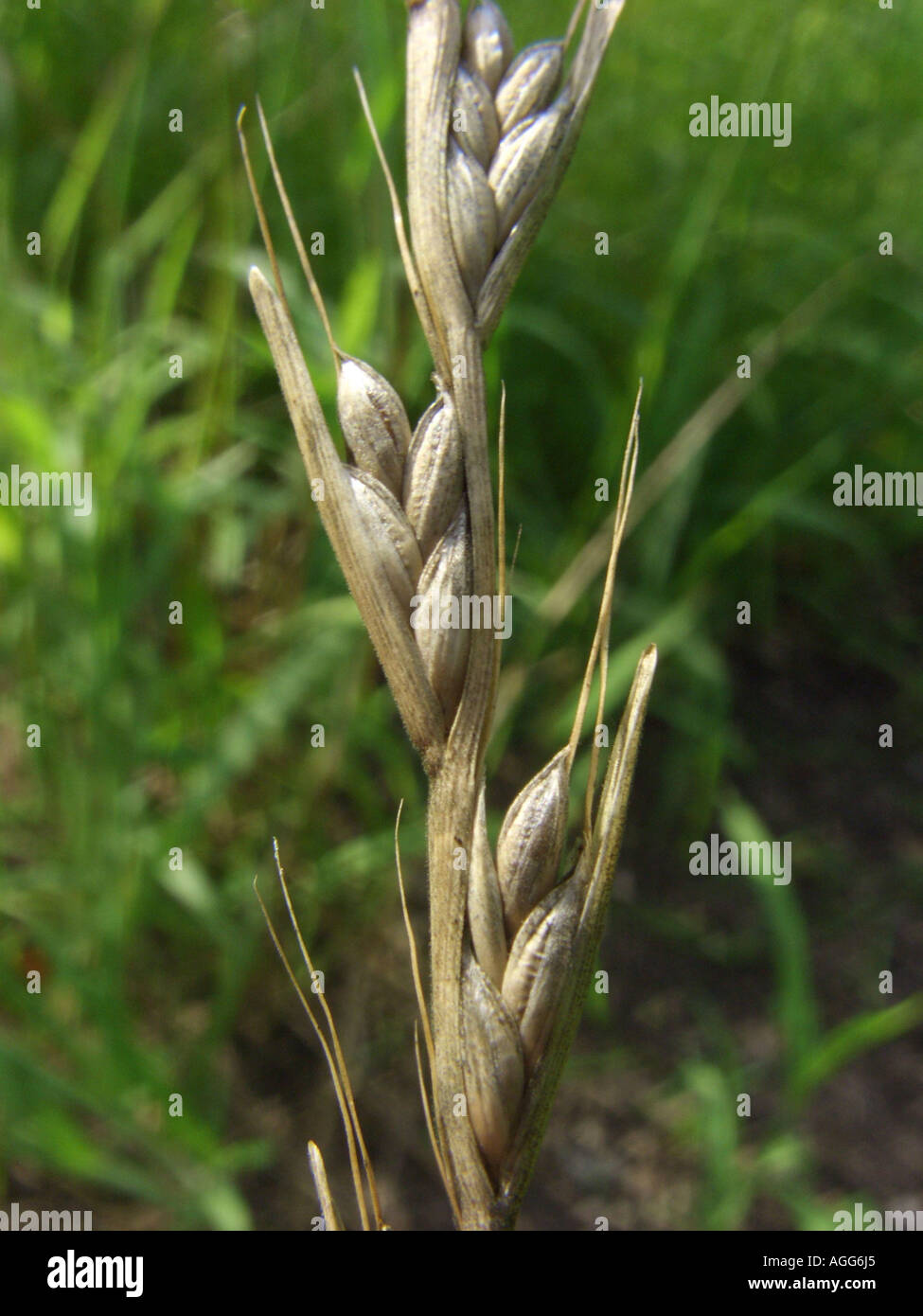 bearded darnel, poison rye-grass (Lolium temulentum), infrutescence Stock Photohttps://www.alamy.com/image-license-details/?v=1https://www.alamy.com/bearded-darnel-poison-rye-grass-lolium-temulentum-infrutescence-image8115364.html
bearded darnel, poison rye-grass (Lolium temulentum), infrutescence Stock Photohttps://www.alamy.com/image-license-details/?v=1https://www.alamy.com/bearded-darnel-poison-rye-grass-lolium-temulentum-infrutescence-image8115364.htmlRMAGG6J5–bearded darnel, poison rye-grass (Lolium temulentum), infrutescence
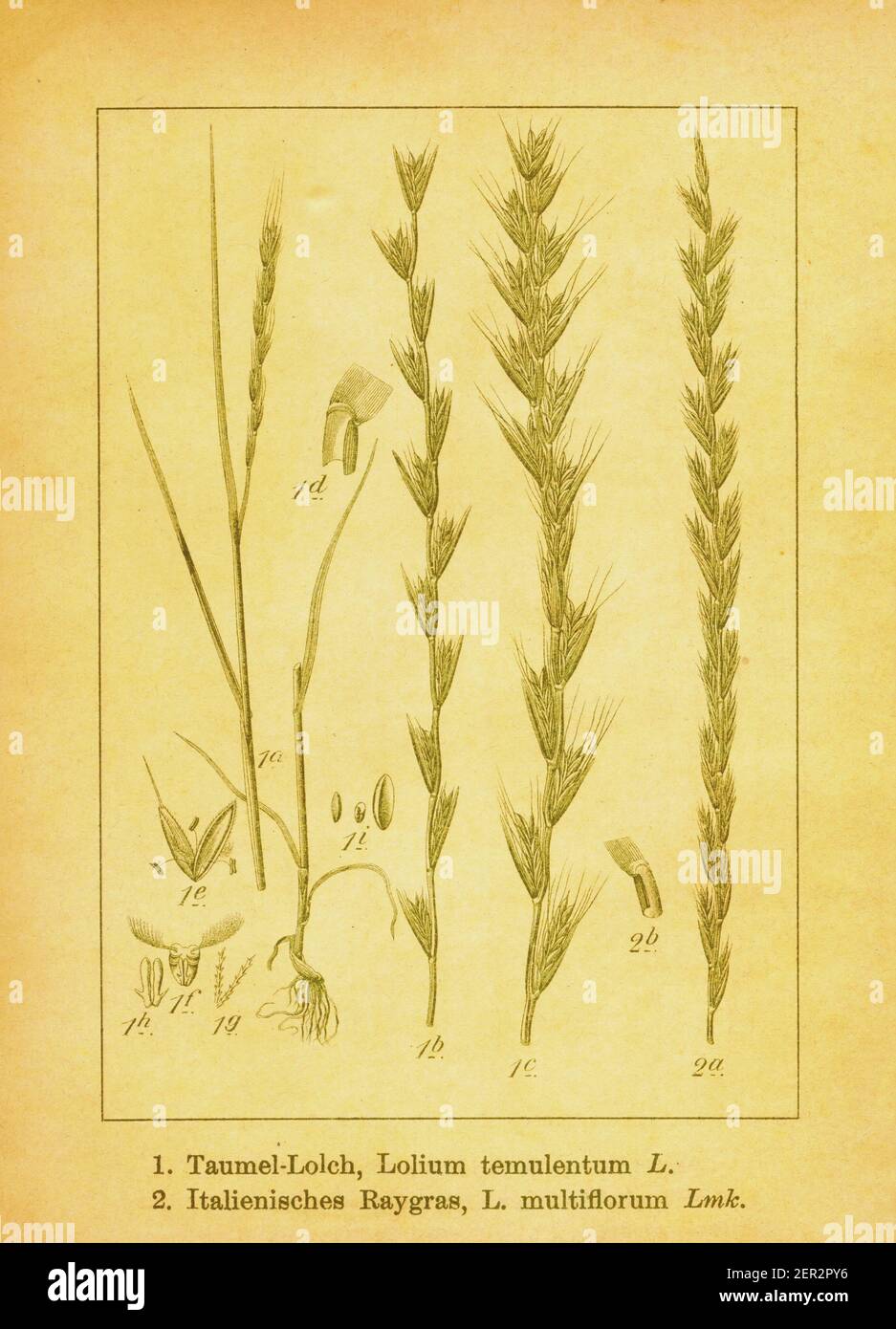 Antique illustration of darnel and Italian ryegrass. Engraving by Jacob Sturm (1771-1848) from the book Deutschlands Flora in Abbildungen nach der Nat Stock Photohttps://www.alamy.com/image-license-details/?v=1https://www.alamy.com/antique-illustration-of-darnel-and-italian-ryegrass-engraving-by-jacob-sturm-1771-1848-from-the-book-deutschlands-flora-in-abbildungen-nach-der-nat-image410037466.html
Antique illustration of darnel and Italian ryegrass. Engraving by Jacob Sturm (1771-1848) from the book Deutschlands Flora in Abbildungen nach der Nat Stock Photohttps://www.alamy.com/image-license-details/?v=1https://www.alamy.com/antique-illustration-of-darnel-and-italian-ryegrass-engraving-by-jacob-sturm-1771-1848-from-the-book-deutschlands-flora-in-abbildungen-nach-der-nat-image410037466.htmlRF2ER2PY6–Antique illustration of darnel and Italian ryegrass. Engraving by Jacob Sturm (1771-1848) from the book Deutschlands Flora in Abbildungen nach der Nat
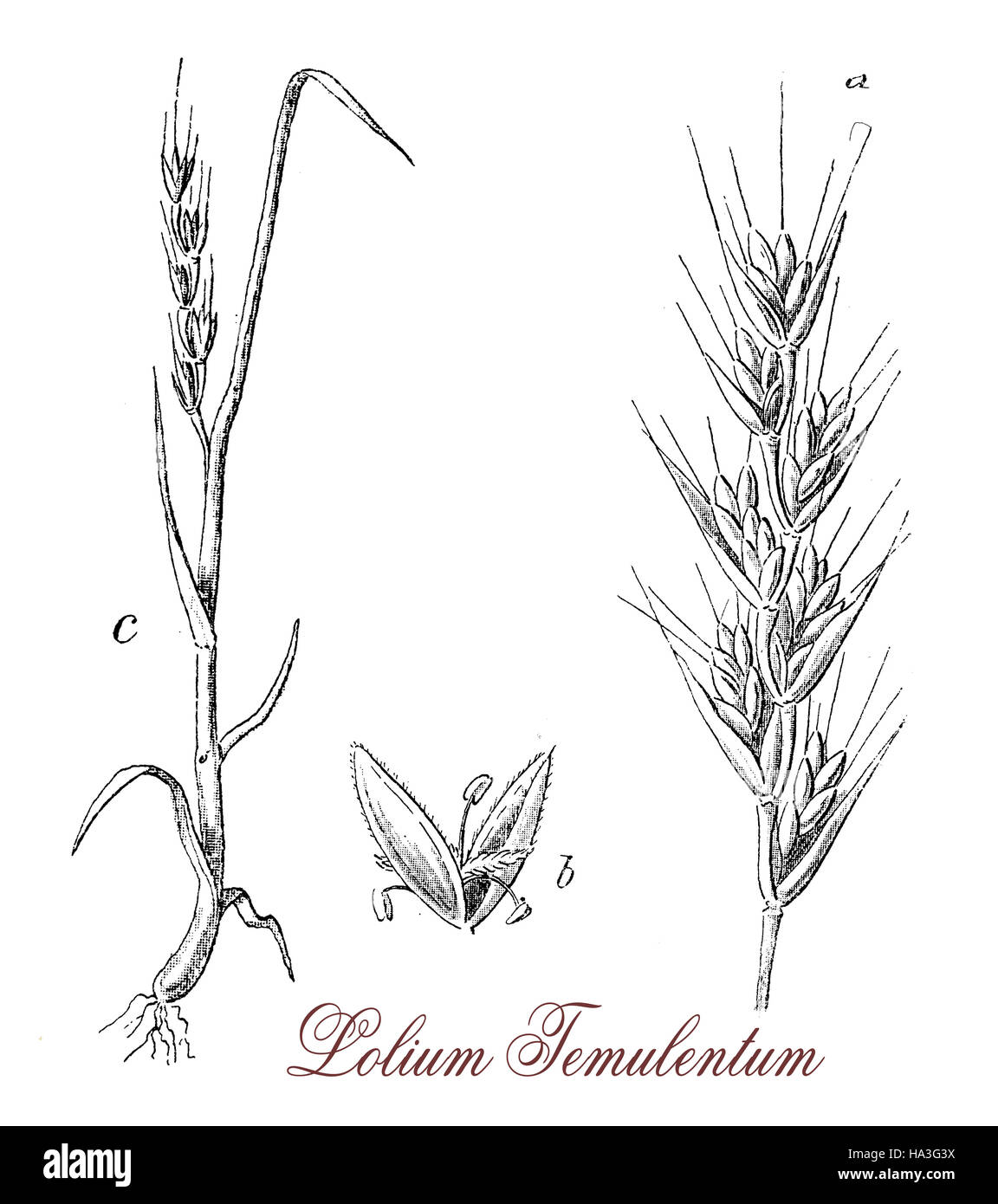 Lolium temulentum or Poison darnel is a weed very similar to wheat, but the ears are different and the grains are purple. It can easily infected by funguses and becomes toxic. Mithridates was supposed to used darnel every day to render himself immune to poisoning. Stock Photohttps://www.alamy.com/image-license-details/?v=1https://www.alamy.com/stock-photo-lolium-temulentum-or-poison-darnel-is-a-weed-very-similar-to-wheat-126697646.html
Lolium temulentum or Poison darnel is a weed very similar to wheat, but the ears are different and the grains are purple. It can easily infected by funguses and becomes toxic. Mithridates was supposed to used darnel every day to render himself immune to poisoning. Stock Photohttps://www.alamy.com/image-license-details/?v=1https://www.alamy.com/stock-photo-lolium-temulentum-or-poison-darnel-is-a-weed-very-similar-to-wheat-126697646.htmlRFHA3G3X–Lolium temulentum or Poison darnel is a weed very similar to wheat, but the ears are different and the grains are purple. It can easily infected by funguses and becomes toxic. Mithridates was supposed to used darnel every day to render himself immune to poisoning.
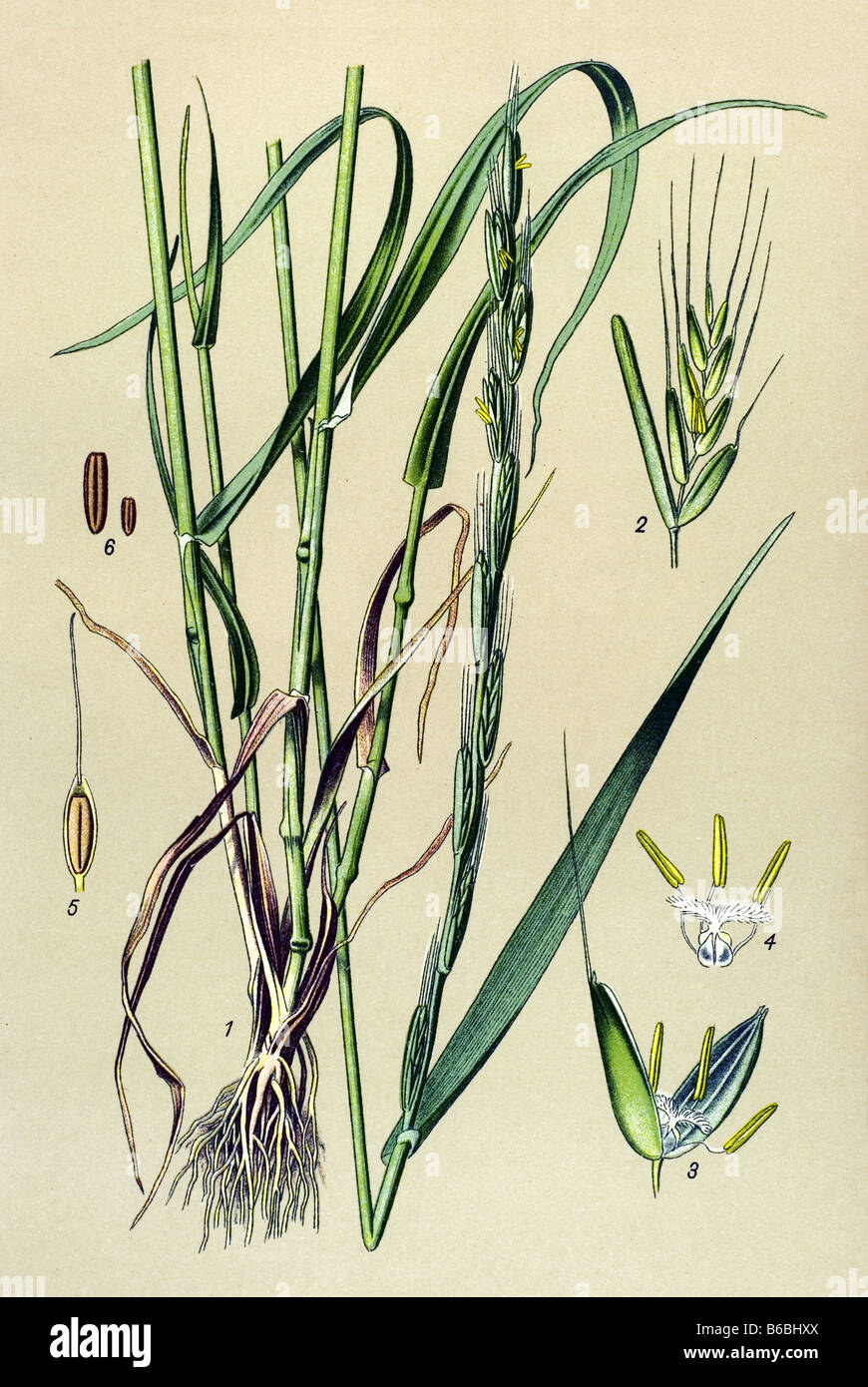 Darnel, Lolium temulentum, poisonous plants illustrations Stock Photohttps://www.alamy.com/image-license-details/?v=1https://www.alamy.com/stock-photo-darnel-lolium-temulentum-poisonous-plants-illustrations-21153858.html
Darnel, Lolium temulentum, poisonous plants illustrations Stock Photohttps://www.alamy.com/image-license-details/?v=1https://www.alamy.com/stock-photo-darnel-lolium-temulentum-poisonous-plants-illustrations-21153858.htmlRMB6BHXX–Darnel, Lolium temulentum, poisonous plants illustrations
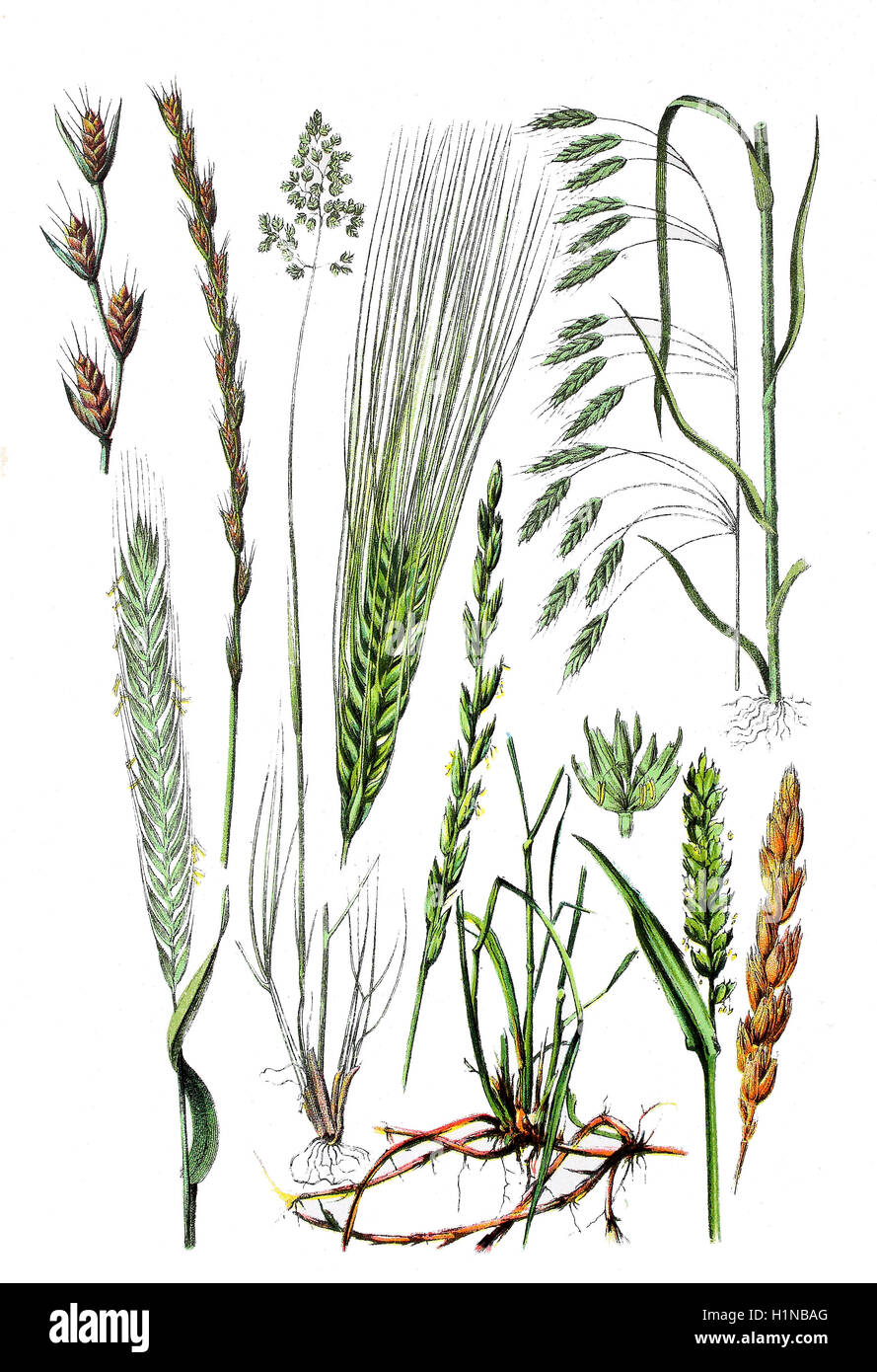 darnel, poison darnel, darnel ryegrass, Lolium temulentum (1. und 2. left top), Rye, Secale cereale (bottem left), Kentucky bluegrass, smooth meadow-grass, Poa pratensis (2. von left bottem), Barley, Hordeum vulgare (center, 4. von left), couch grass, Elymus repens (bottem, 3. und 4. von left), bread wheat, Triticum aestivum (right bottem), rye brome, Bromus secalinus (top right) Stock Photohttps://www.alamy.com/image-license-details/?v=1https://www.alamy.com/stock-photo-darnel-poison-darnel-darnel-ryegrass-lolium-temulentum-1-und-2-left-121557144.html
darnel, poison darnel, darnel ryegrass, Lolium temulentum (1. und 2. left top), Rye, Secale cereale (bottem left), Kentucky bluegrass, smooth meadow-grass, Poa pratensis (2. von left bottem), Barley, Hordeum vulgare (center, 4. von left), couch grass, Elymus repens (bottem, 3. und 4. von left), bread wheat, Triticum aestivum (right bottem), rye brome, Bromus secalinus (top right) Stock Photohttps://www.alamy.com/image-license-details/?v=1https://www.alamy.com/stock-photo-darnel-poison-darnel-darnel-ryegrass-lolium-temulentum-1-und-2-left-121557144.htmlRFH1NBAG–darnel, poison darnel, darnel ryegrass, Lolium temulentum (1. und 2. left top), Rye, Secale cereale (bottem left), Kentucky bluegrass, smooth meadow-grass, Poa pratensis (2. von left bottem), Barley, Hordeum vulgare (center, 4. von left), couch grass, Elymus repens (bottem, 3. und 4. von left), bread wheat, Triticum aestivum (right bottem), rye brome, Bromus secalinus (top right)
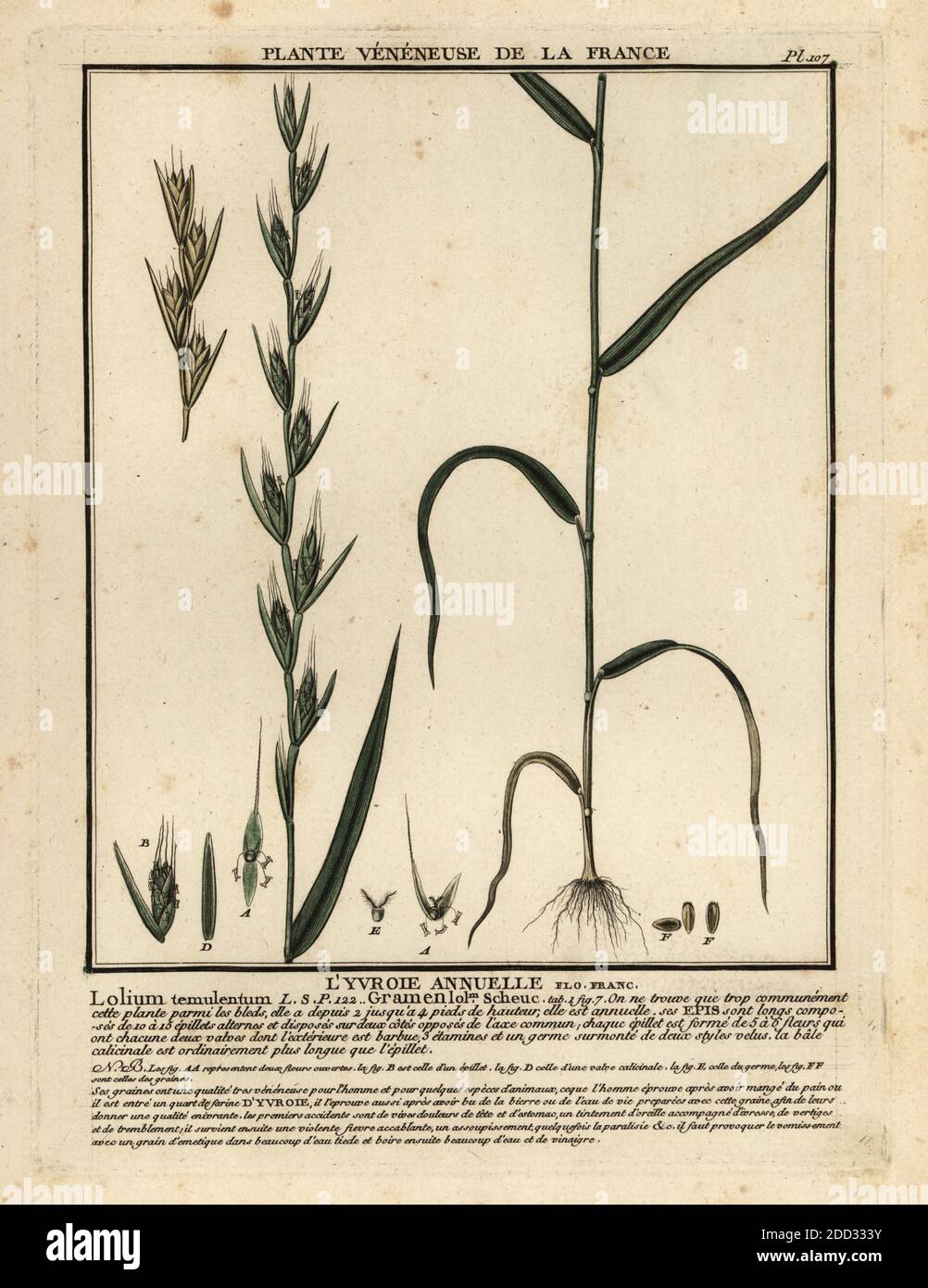 Poison darnel, darnel ryegrass or cockle, L’yvroie annuelle, l’ivraie annuelle, Lolium temulentum. Copperplate engraving printed in three colours by Pierre Bulliard from his Herbier de la France, ou collection complete des plantes indigenes de ce royaume, Didot jeune, Debure et Belin, 1780-1793. Stock Photohttps://www.alamy.com/image-license-details/?v=1https://www.alamy.com/poison-darnel-darnel-ryegrass-or-cockle-lyvroie-annuelle-livraie-annuelle-lolium-temulentum-copperplate-engraving-printed-in-three-colours-by-pierre-bulliard-from-his-herbier-de-la-france-ou-collection-complete-des-plantes-indigenes-de-ce-royaume-didot-jeune-debure-et-belin-1780-1793-image386686943.html
Poison darnel, darnel ryegrass or cockle, L’yvroie annuelle, l’ivraie annuelle, Lolium temulentum. Copperplate engraving printed in three colours by Pierre Bulliard from his Herbier de la France, ou collection complete des plantes indigenes de ce royaume, Didot jeune, Debure et Belin, 1780-1793. Stock Photohttps://www.alamy.com/image-license-details/?v=1https://www.alamy.com/poison-darnel-darnel-ryegrass-or-cockle-lyvroie-annuelle-livraie-annuelle-lolium-temulentum-copperplate-engraving-printed-in-three-colours-by-pierre-bulliard-from-his-herbier-de-la-france-ou-collection-complete-des-plantes-indigenes-de-ce-royaume-didot-jeune-debure-et-belin-1780-1793-image386686943.htmlRM2DD333Y–Poison darnel, darnel ryegrass or cockle, L’yvroie annuelle, l’ivraie annuelle, Lolium temulentum. Copperplate engraving printed in three colours by Pierre Bulliard from his Herbier de la France, ou collection complete des plantes indigenes de ce royaume, Didot jeune, Debure et Belin, 1780-1793.
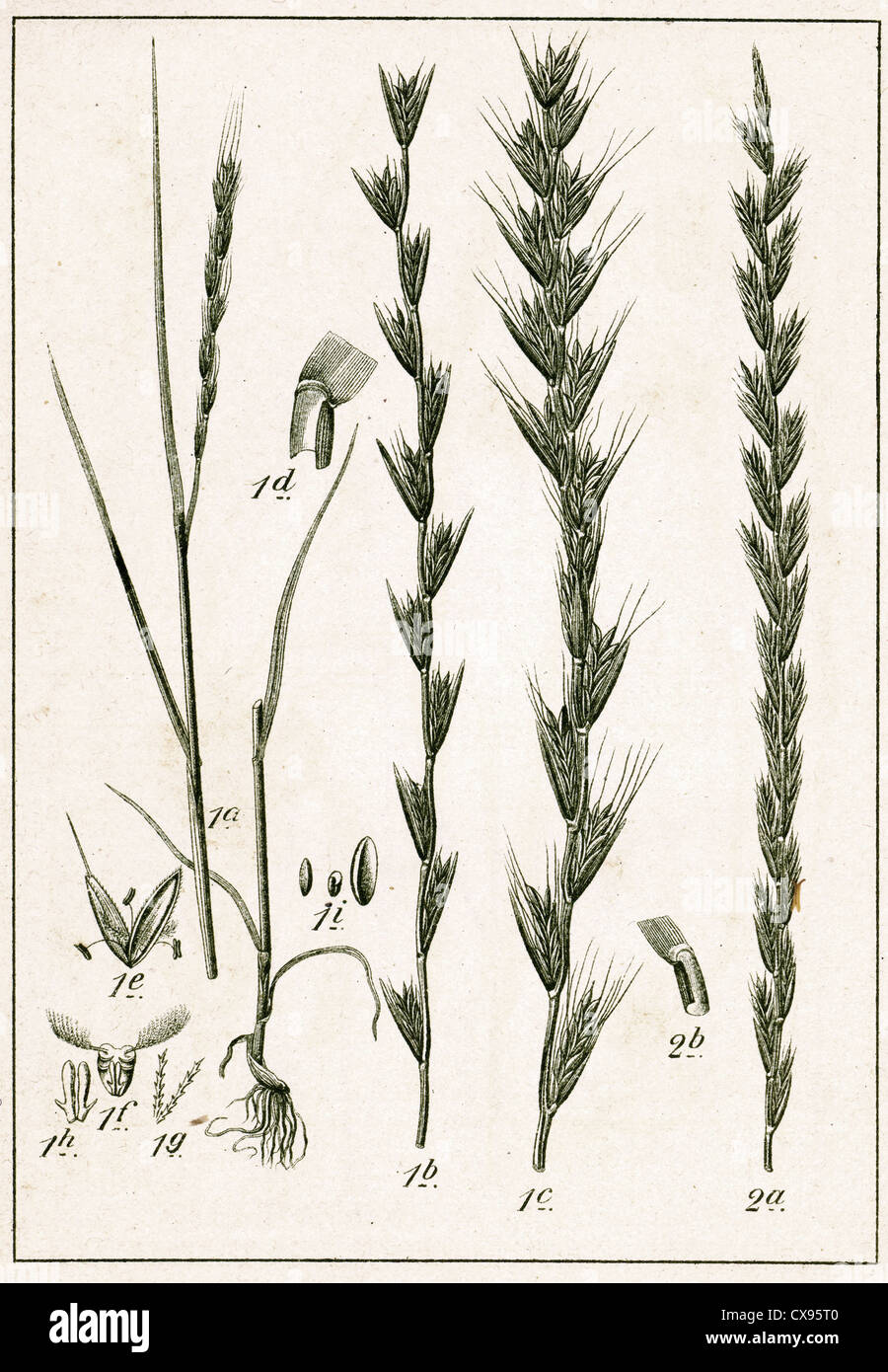 Lolium temulentum - Lolium multiflorum Stock Photohttps://www.alamy.com/image-license-details/?v=1https://www.alamy.com/stock-photo-lolium-temulentum-lolium-multiflorum-50603952.html
Lolium temulentum - Lolium multiflorum Stock Photohttps://www.alamy.com/image-license-details/?v=1https://www.alamy.com/stock-photo-lolium-temulentum-lolium-multiflorum-50603952.htmlRMCX95T0–Lolium temulentum - Lolium multiflorum
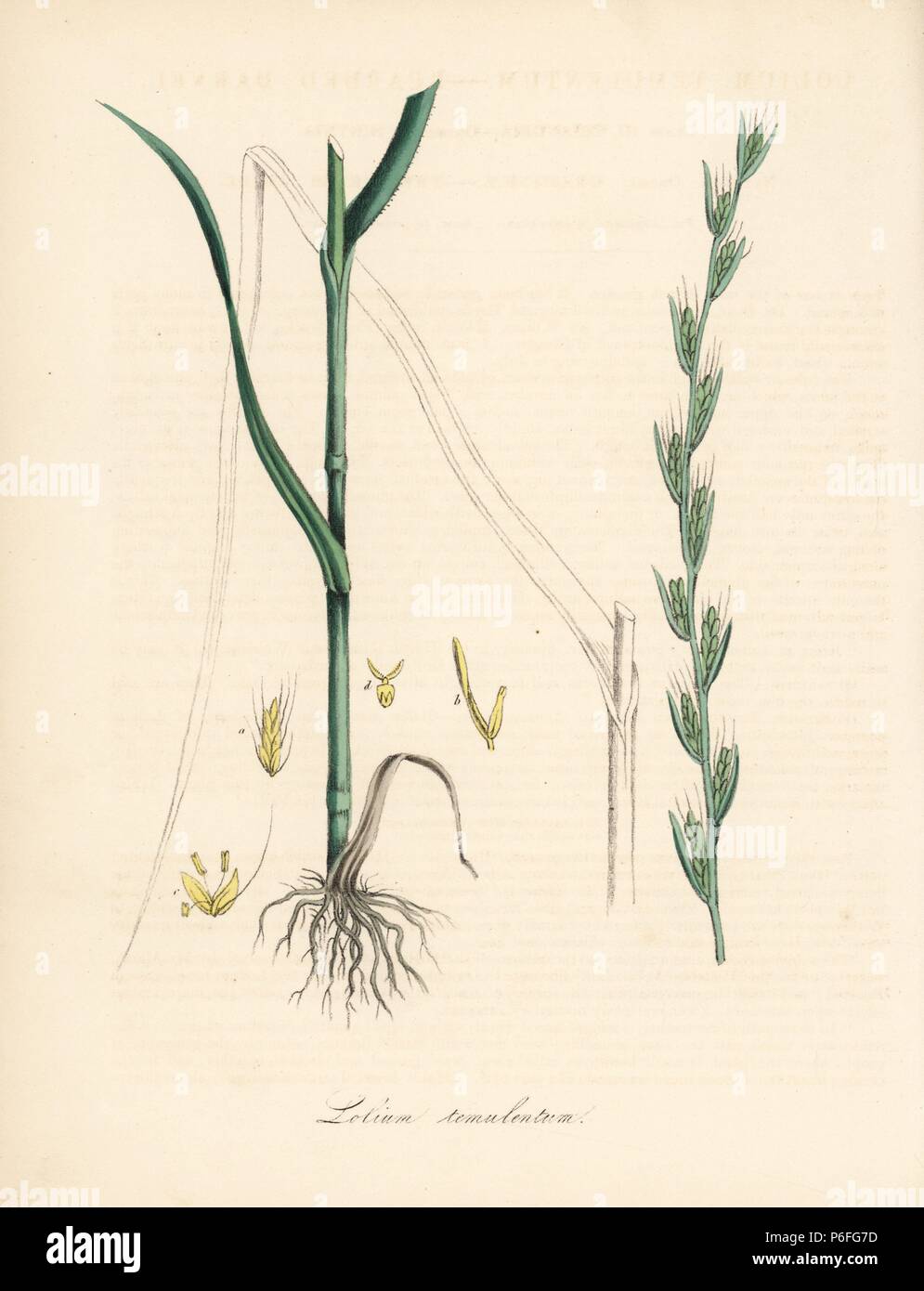 Bearded darnel or poison darnel, Lolium temulentum, with stalk, leaf, roots and seed. Handcoloured zincograph by C. Chabot drawn by Miss M. A. Burnett from her 'Plantae Utiliores: or Illustrations of Useful Plants,' Whittaker, London, 1842. Miss Burnett drew the botanical illustrations, but the text was chiefly by her late brother, British botanist Gilbert Thomas Burnett (1800-1835). Stock Photohttps://www.alamy.com/image-license-details/?v=1https://www.alamy.com/bearded-darnel-or-poison-darnel-lolium-temulentum-with-stalk-leaf-roots-and-seed-handcoloured-zincograph-by-c-chabot-drawn-by-miss-m-a-burnett-from-her-plantae-utiliores-or-illustrations-of-useful-plants-whittaker-london-1842-miss-burnett-drew-the-botanical-illustrations-but-the-text-was-chiefly-by-her-late-brother-british-botanist-gilbert-thomas-burnett-1800-1835-image210554385.html
Bearded darnel or poison darnel, Lolium temulentum, with stalk, leaf, roots and seed. Handcoloured zincograph by C. Chabot drawn by Miss M. A. Burnett from her 'Plantae Utiliores: or Illustrations of Useful Plants,' Whittaker, London, 1842. Miss Burnett drew the botanical illustrations, but the text was chiefly by her late brother, British botanist Gilbert Thomas Burnett (1800-1835). Stock Photohttps://www.alamy.com/image-license-details/?v=1https://www.alamy.com/bearded-darnel-or-poison-darnel-lolium-temulentum-with-stalk-leaf-roots-and-seed-handcoloured-zincograph-by-c-chabot-drawn-by-miss-m-a-burnett-from-her-plantae-utiliores-or-illustrations-of-useful-plants-whittaker-london-1842-miss-burnett-drew-the-botanical-illustrations-but-the-text-was-chiefly-by-her-late-brother-british-botanist-gilbert-thomas-burnett-1800-1835-image210554385.htmlRMP6FG7D–Bearded darnel or poison darnel, Lolium temulentum, with stalk, leaf, roots and seed. Handcoloured zincograph by C. Chabot drawn by Miss M. A. Burnett from her 'Plantae Utiliores: or Illustrations of Useful Plants,' Whittaker, London, 1842. Miss Burnett drew the botanical illustrations, but the text was chiefly by her late brother, British botanist Gilbert Thomas Burnett (1800-1835).
 Lolium temulenturm, darnel, poison darnel or cockle Stock Photohttps://www.alamy.com/image-license-details/?v=1https://www.alamy.com/stock-photo-lolium-temulenturm-darnel-poison-darnel-or-cockle-41948969.html
Lolium temulenturm, darnel, poison darnel or cockle Stock Photohttps://www.alamy.com/image-license-details/?v=1https://www.alamy.com/stock-photo-lolium-temulenturm-darnel-poison-darnel-or-cockle-41948969.htmlRFCC6X9D–Lolium temulenturm, darnel, poison darnel or cockle
 . A manual of weeds : with descriptions of all the most pernicious and troublesome plants in the United States and Canada, their habits of growth and distribution, with methods of control . Weeds. GRAMINEAE (GRASS FAMILY) empty glume at the base slightly shorter than the spikelet, a charactei which distinguishes it from its annual relative the Poison Darnel, which has the subtending empty glume longer than the spikelet. Means of control Sow clean seed. Prevent the production of seed by early cutting. Though perennial, it is rather short-lived, and if not allowed to seed, may soon be crowded ou Stock Photohttps://www.alamy.com/image-license-details/?v=1https://www.alamy.com/a-manual-of-weeds-with-descriptions-of-all-the-most-pernicious-and-troublesome-plants-in-the-united-states-and-canada-their-habits-of-growth-and-distribution-with-methods-of-control-weeds-gramineae-grass-family-empty-glume-at-the-base-slightly-shorter-than-the-spikelet-a-charactei-which-distinguishes-it-from-its-annual-relative-the-poison-darnel-which-has-the-subtending-empty-glume-longer-than-the-spikelet-means-of-control-sow-clean-seed-prevent-the-production-of-seed-by-early-cutting-though-perennial-it-is-rather-short-lived-and-if-not-allowed-to-seed-may-soon-be-crowded-ou-image216405697.html
. A manual of weeds : with descriptions of all the most pernicious and troublesome plants in the United States and Canada, their habits of growth and distribution, with methods of control . Weeds. GRAMINEAE (GRASS FAMILY) empty glume at the base slightly shorter than the spikelet, a charactei which distinguishes it from its annual relative the Poison Darnel, which has the subtending empty glume longer than the spikelet. Means of control Sow clean seed. Prevent the production of seed by early cutting. Though perennial, it is rather short-lived, and if not allowed to seed, may soon be crowded ou Stock Photohttps://www.alamy.com/image-license-details/?v=1https://www.alamy.com/a-manual-of-weeds-with-descriptions-of-all-the-most-pernicious-and-troublesome-plants-in-the-united-states-and-canada-their-habits-of-growth-and-distribution-with-methods-of-control-weeds-gramineae-grass-family-empty-glume-at-the-base-slightly-shorter-than-the-spikelet-a-charactei-which-distinguishes-it-from-its-annual-relative-the-poison-darnel-which-has-the-subtending-empty-glume-longer-than-the-spikelet-means-of-control-sow-clean-seed-prevent-the-production-of-seed-by-early-cutting-though-perennial-it-is-rather-short-lived-and-if-not-allowed-to-seed-may-soon-be-crowded-ou-image216405697.htmlRMPG23JW–. A manual of weeds : with descriptions of all the most pernicious and troublesome plants in the United States and Canada, their habits of growth and distribution, with methods of control . Weeds. GRAMINEAE (GRASS FAMILY) empty glume at the base slightly shorter than the spikelet, a charactei which distinguishes it from its annual relative the Poison Darnel, which has the subtending empty glume longer than the spikelet. Means of control Sow clean seed. Prevent the production of seed by early cutting. Though perennial, it is rather short-lived, and if not allowed to seed, may soon be crowded ou
 . A manual of weeds : with descriptions of all the most pernicious and troublesome plants in the United States and Canada, their habits of growth and distribution, with methods of control . Weeds. GRAMINEAE (GRASS FAMILY) empty glume at the base slightly shorter than the spikelet, a charactei which distinguishes it from its annual relative the Poison Darnel, which has the subtending empty glume longer than the spikelet. Means of control Sow clean seed. Prevent the production of seed by early cutting. Though perennial, it is rather short-lived, and if not allowed to seed, may soon be crowded ou Stock Photohttps://www.alamy.com/image-license-details/?v=1https://www.alamy.com/a-manual-of-weeds-with-descriptions-of-all-the-most-pernicious-and-troublesome-plants-in-the-united-states-and-canada-their-habits-of-growth-and-distribution-with-methods-of-control-weeds-gramineae-grass-family-empty-glume-at-the-base-slightly-shorter-than-the-spikelet-a-charactei-which-distinguishes-it-from-its-annual-relative-the-poison-darnel-which-has-the-subtending-empty-glume-longer-than-the-spikelet-means-of-control-sow-clean-seed-prevent-the-production-of-seed-by-early-cutting-though-perennial-it-is-rather-short-lived-and-if-not-allowed-to-seed-may-soon-be-crowded-ou-image231942997.html
. A manual of weeds : with descriptions of all the most pernicious and troublesome plants in the United States and Canada, their habits of growth and distribution, with methods of control . Weeds. GRAMINEAE (GRASS FAMILY) empty glume at the base slightly shorter than the spikelet, a charactei which distinguishes it from its annual relative the Poison Darnel, which has the subtending empty glume longer than the spikelet. Means of control Sow clean seed. Prevent the production of seed by early cutting. Though perennial, it is rather short-lived, and if not allowed to seed, may soon be crowded ou Stock Photohttps://www.alamy.com/image-license-details/?v=1https://www.alamy.com/a-manual-of-weeds-with-descriptions-of-all-the-most-pernicious-and-troublesome-plants-in-the-united-states-and-canada-their-habits-of-growth-and-distribution-with-methods-of-control-weeds-gramineae-grass-family-empty-glume-at-the-base-slightly-shorter-than-the-spikelet-a-charactei-which-distinguishes-it-from-its-annual-relative-the-poison-darnel-which-has-the-subtending-empty-glume-longer-than-the-spikelet-means-of-control-sow-clean-seed-prevent-the-production-of-seed-by-early-cutting-though-perennial-it-is-rather-short-lived-and-if-not-allowed-to-seed-may-soon-be-crowded-ou-image231942997.htmlRMRD9WJD–. A manual of weeds : with descriptions of all the most pernicious and troublesome plants in the United States and Canada, their habits of growth and distribution, with methods of control . Weeds. GRAMINEAE (GRASS FAMILY) empty glume at the base slightly shorter than the spikelet, a charactei which distinguishes it from its annual relative the Poison Darnel, which has the subtending empty glume longer than the spikelet. Means of control Sow clean seed. Prevent the production of seed by early cutting. Though perennial, it is rather short-lived, and if not allowed to seed, may soon be crowded ou
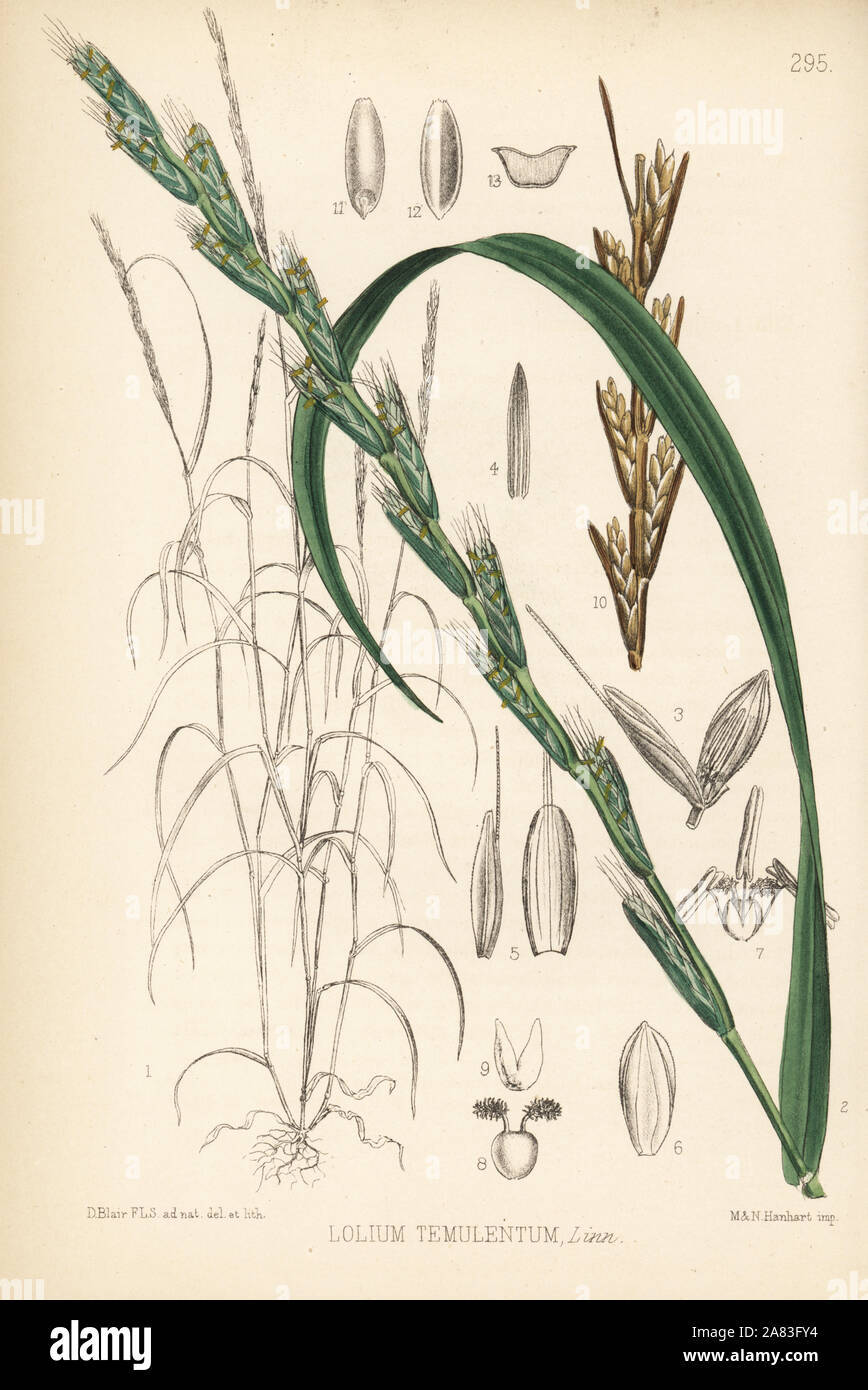 Bearded darnel, Lolium temulentum. Handcoloured lithograph by Hanhart after a botanical illustration by David Blair from Robert Bentley and Henry Trimen's Medicinal Plants, London, 1880. Stock Photohttps://www.alamy.com/image-license-details/?v=1https://www.alamy.com/bearded-darnel-lolium-temulentum-handcoloured-lithograph-by-hanhart-after-a-botanical-illustration-by-david-blair-from-robert-bentley-and-henry-trimens-medicinal-plants-london-1880-image331992616.html
Bearded darnel, Lolium temulentum. Handcoloured lithograph by Hanhart after a botanical illustration by David Blair from Robert Bentley and Henry Trimen's Medicinal Plants, London, 1880. Stock Photohttps://www.alamy.com/image-license-details/?v=1https://www.alamy.com/bearded-darnel-lolium-temulentum-handcoloured-lithograph-by-hanhart-after-a-botanical-illustration-by-david-blair-from-robert-bentley-and-henry-trimens-medicinal-plants-london-1880-image331992616.htmlRM2A83FY4–Bearded darnel, Lolium temulentum. Handcoloured lithograph by Hanhart after a botanical illustration by David Blair from Robert Bentley and Henry Trimen's Medicinal Plants, London, 1880.
 Lolium temulentum or Darnel or Poison darnel or Cockle, vintage engraved illustration. Dictionary of words and things - Larive a Stock Vectorhttps://www.alamy.com/image-license-details/?v=1https://www.alamy.com/stock-photo-lolium-temulentum-or-darnel-or-poison-darnel-or-cockle-vintage-engraved-84422824.html
Lolium temulentum or Darnel or Poison darnel or Cockle, vintage engraved illustration. Dictionary of words and things - Larive a Stock Vectorhttps://www.alamy.com/image-license-details/?v=1https://www.alamy.com/stock-photo-lolium-temulentum-or-darnel-or-poison-darnel-or-cockle-vintage-engraved-84422824.htmlRFEW9P4T–Lolium temulentum or Darnel or Poison darnel or Cockle, vintage engraved illustration. Dictionary of words and things - Larive a
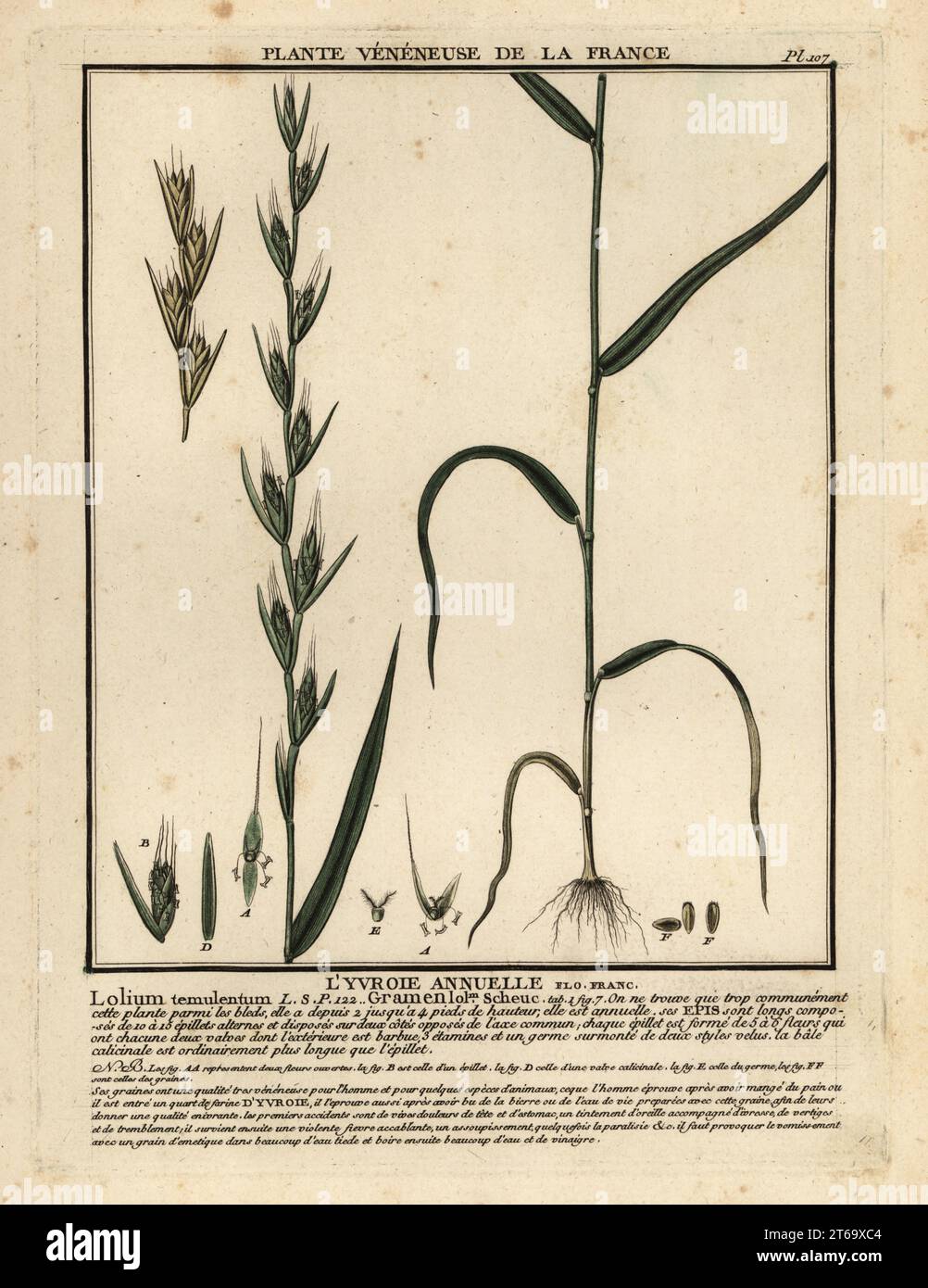 Poison darnel, darnel ryegrass or cockle, Lyvroie annuelle, livraie annuelle, Lolium temulentum. Copperplate engraving printed in three colours by Pierre Bulliard from his Herbier de la France, ou collection complete des plantes indigenes de ce royaume, Didot jeune, Debure et Belin, 1780-1793. Stock Photohttps://www.alamy.com/image-license-details/?v=1https://www.alamy.com/poison-darnel-darnel-ryegrass-or-cockle-lyvroie-annuelle-livraie-annuelle-lolium-temulentum-copperplate-engraving-printed-in-three-colours-by-pierre-bulliard-from-his-herbier-de-la-france-ou-collection-complete-des-plantes-indigenes-de-ce-royaume-didot-jeune-debure-et-belin-1780-1793-image571848372.html
Poison darnel, darnel ryegrass or cockle, Lyvroie annuelle, livraie annuelle, Lolium temulentum. Copperplate engraving printed in three colours by Pierre Bulliard from his Herbier de la France, ou collection complete des plantes indigenes de ce royaume, Didot jeune, Debure et Belin, 1780-1793. Stock Photohttps://www.alamy.com/image-license-details/?v=1https://www.alamy.com/poison-darnel-darnel-ryegrass-or-cockle-lyvroie-annuelle-livraie-annuelle-lolium-temulentum-copperplate-engraving-printed-in-three-colours-by-pierre-bulliard-from-his-herbier-de-la-france-ou-collection-complete-des-plantes-indigenes-de-ce-royaume-didot-jeune-debure-et-belin-1780-1793-image571848372.htmlRM2T69XC4–Poison darnel, darnel ryegrass or cockle, Lyvroie annuelle, livraie annuelle, Lolium temulentum. Copperplate engraving printed in three colours by Pierre Bulliard from his Herbier de la France, ou collection complete des plantes indigenes de ce royaume, Didot jeune, Debure et Belin, 1780-1793.
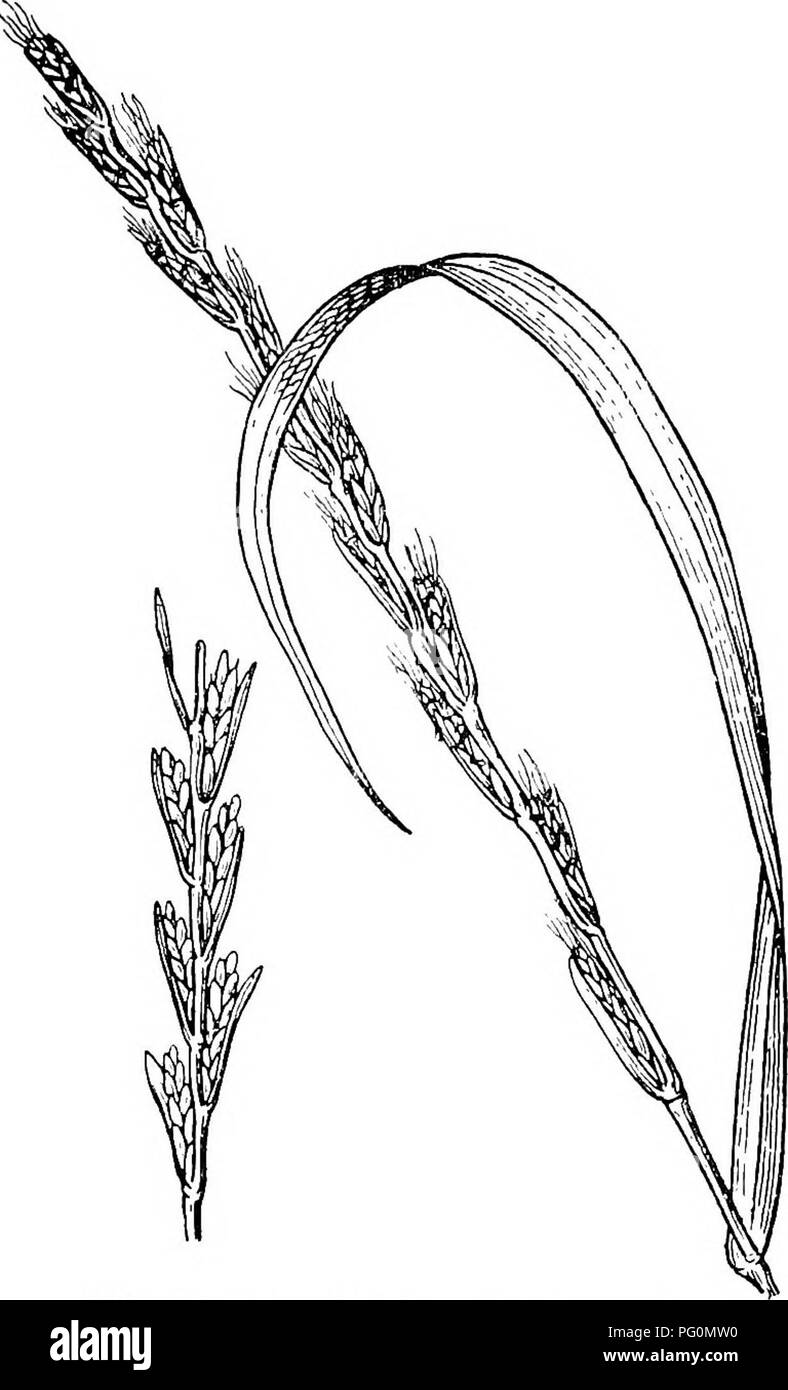 . A manual of veterinary hygiene. Veterinary hygiene. 186 VETEKINAEY HYGIENE who found that Lolium was only poisonous to horses in con- siderable doses, two to six pounds, more than is ever likely to be obtained by ordinary grazing or in hay. The poison is known as Temuline and is said not to affect oxen, but poisons other animals, including man. It produces vertigo, and symptoms of loss of co-ordination.. Fig. 49.—Darnel {Lolium temulentum). These are not the only poisonous grasses. Bromus catharticus is a purgative, Festuca quadrivalvis, a grass grow- ing in Peru, and the Molinia ccerulea, a Stock Photohttps://www.alamy.com/image-license-details/?v=1https://www.alamy.com/a-manual-of-veterinary-hygiene-veterinary-hygiene-186-vetekinaey-hygiene-who-found-that-lolium-was-only-poisonous-to-horses-in-con-siderable-doses-two-to-six-pounds-more-than-is-ever-likely-to-be-obtained-by-ordinary-grazing-or-in-hay-the-poison-is-known-as-temuline-and-is-said-not-to-affect-oxen-but-poisons-other-animals-including-man-it-produces-vertigo-and-symptoms-of-loss-of-co-ordination-fig-49darnel-lolium-temulentum-these-are-not-the-only-poisonous-grasses-bromus-catharticus-is-a-purgative-festuca-quadrivalvis-a-grass-grow-ing-in-peru-and-the-molinia-ccerulea-a-image216375292.html
. A manual of veterinary hygiene. Veterinary hygiene. 186 VETEKINAEY HYGIENE who found that Lolium was only poisonous to horses in con- siderable doses, two to six pounds, more than is ever likely to be obtained by ordinary grazing or in hay. The poison is known as Temuline and is said not to affect oxen, but poisons other animals, including man. It produces vertigo, and symptoms of loss of co-ordination.. Fig. 49.—Darnel {Lolium temulentum). These are not the only poisonous grasses. Bromus catharticus is a purgative, Festuca quadrivalvis, a grass grow- ing in Peru, and the Molinia ccerulea, a Stock Photohttps://www.alamy.com/image-license-details/?v=1https://www.alamy.com/a-manual-of-veterinary-hygiene-veterinary-hygiene-186-vetekinaey-hygiene-who-found-that-lolium-was-only-poisonous-to-horses-in-con-siderable-doses-two-to-six-pounds-more-than-is-ever-likely-to-be-obtained-by-ordinary-grazing-or-in-hay-the-poison-is-known-as-temuline-and-is-said-not-to-affect-oxen-but-poisons-other-animals-including-man-it-produces-vertigo-and-symptoms-of-loss-of-co-ordination-fig-49darnel-lolium-temulentum-these-are-not-the-only-poisonous-grasses-bromus-catharticus-is-a-purgative-festuca-quadrivalvis-a-grass-grow-ing-in-peru-and-the-molinia-ccerulea-a-image216375292.htmlRMPG0MW0–. A manual of veterinary hygiene. Veterinary hygiene. 186 VETEKINAEY HYGIENE who found that Lolium was only poisonous to horses in con- siderable doses, two to six pounds, more than is ever likely to be obtained by ordinary grazing or in hay. The poison is known as Temuline and is said not to affect oxen, but poisons other animals, including man. It produces vertigo, and symptoms of loss of co-ordination.. Fig. 49.—Darnel {Lolium temulentum). These are not the only poisonous grasses. Bromus catharticus is a purgative, Festuca quadrivalvis, a grass grow- ing in Peru, and the Molinia ccerulea, a
 . A manual of poisonous plants, chiefly of eastern North America, with brief notes on economic and medicinal plants, and numerous illustrations. Poisonous plants. SPERMATOPHYTA—GRAMINEAE—GRASSES 363 speaks of it as communicating these intoxicating properties to beer. It acts as a narcotic, acrid poison. Darnel meal was formerly recommended as a sedative poultice. In Taylor's work on poisons, the statement is made that the seeds, whether in powder or in decoctions, have a local action on the alimentary canal and a remote action on the brain and nervous system. He states further that no instance Stock Photohttps://www.alamy.com/image-license-details/?v=1https://www.alamy.com/a-manual-of-poisonous-plants-chiefly-of-eastern-north-america-with-brief-notes-on-economic-and-medicinal-plants-and-numerous-illustrations-poisonous-plants-spermatophytagramineaegrasses-363-speaks-of-it-as-communicating-these-intoxicating-properties-to-beer-it-acts-as-a-narcotic-acrid-poison-darnel-meal-was-formerly-recommended-as-a-sedative-poultice-in-taylors-work-on-poisons-the-statement-is-made-that-the-seeds-whether-in-powder-or-in-decoctions-have-a-local-action-on-the-alimentary-canal-and-a-remote-action-on-the-brain-and-nervous-system-he-states-further-that-no-instance-image232328487.html
. A manual of poisonous plants, chiefly of eastern North America, with brief notes on economic and medicinal plants, and numerous illustrations. Poisonous plants. SPERMATOPHYTA—GRAMINEAE—GRASSES 363 speaks of it as communicating these intoxicating properties to beer. It acts as a narcotic, acrid poison. Darnel meal was formerly recommended as a sedative poultice. In Taylor's work on poisons, the statement is made that the seeds, whether in powder or in decoctions, have a local action on the alimentary canal and a remote action on the brain and nervous system. He states further that no instance Stock Photohttps://www.alamy.com/image-license-details/?v=1https://www.alamy.com/a-manual-of-poisonous-plants-chiefly-of-eastern-north-america-with-brief-notes-on-economic-and-medicinal-plants-and-numerous-illustrations-poisonous-plants-spermatophytagramineaegrasses-363-speaks-of-it-as-communicating-these-intoxicating-properties-to-beer-it-acts-as-a-narcotic-acrid-poison-darnel-meal-was-formerly-recommended-as-a-sedative-poultice-in-taylors-work-on-poisons-the-statement-is-made-that-the-seeds-whether-in-powder-or-in-decoctions-have-a-local-action-on-the-alimentary-canal-and-a-remote-action-on-the-brain-and-nervous-system-he-states-further-that-no-instance-image232328487.htmlRMRDYD9Y–. A manual of poisonous plants, chiefly of eastern North America, with brief notes on economic and medicinal plants, and numerous illustrations. Poisonous plants. SPERMATOPHYTA—GRAMINEAE—GRASSES 363 speaks of it as communicating these intoxicating properties to beer. It acts as a narcotic, acrid poison. Darnel meal was formerly recommended as a sedative poultice. In Taylor's work on poisons, the statement is made that the seeds, whether in powder or in decoctions, have a local action on the alimentary canal and a remote action on the brain and nervous system. He states further that no instance
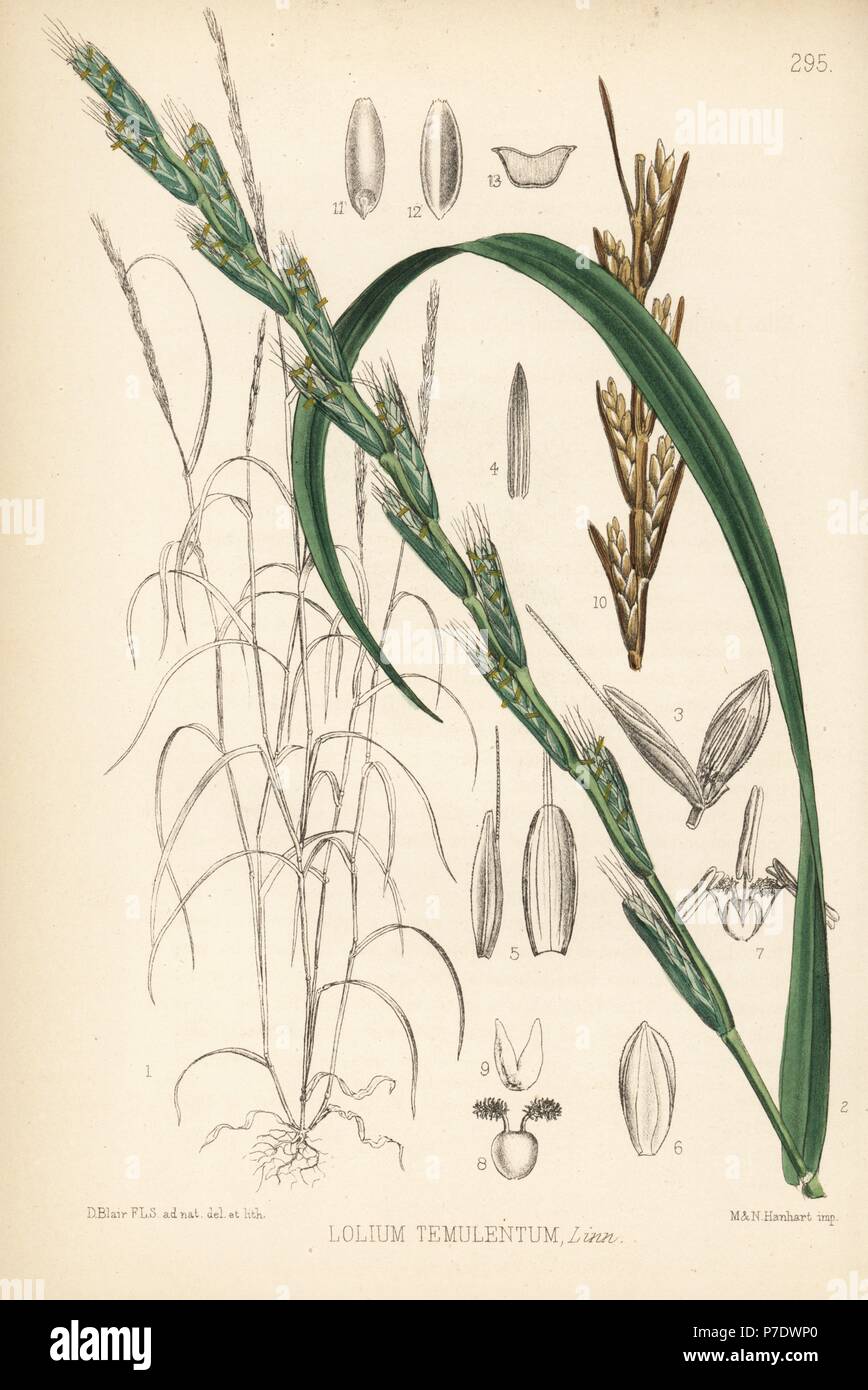 Bearded darnel, Lolium temulentum. Handcoloured lithograph by Hanhart after a botanical illustration by David Blair from Robert Bentley and Henry Trimen's Medicinal Plants, London, 1880. Stock Photohttps://www.alamy.com/image-license-details/?v=1https://www.alamy.com/bearded-darnel-lolium-temulentum-handcoloured-lithograph-by-hanhart-after-a-botanical-illustration-by-david-blair-from-robert-bentley-and-henry-trimens-medicinal-plants-london-1880-image211132600.html
Bearded darnel, Lolium temulentum. Handcoloured lithograph by Hanhart after a botanical illustration by David Blair from Robert Bentley and Henry Trimen's Medicinal Plants, London, 1880. Stock Photohttps://www.alamy.com/image-license-details/?v=1https://www.alamy.com/bearded-darnel-lolium-temulentum-handcoloured-lithograph-by-hanhart-after-a-botanical-illustration-by-david-blair-from-robert-bentley-and-henry-trimens-medicinal-plants-london-1880-image211132600.htmlRMP7DWP0–Bearded darnel, Lolium temulentum. Handcoloured lithograph by Hanhart after a botanical illustration by David Blair from Robert Bentley and Henry Trimen's Medicinal Plants, London, 1880.
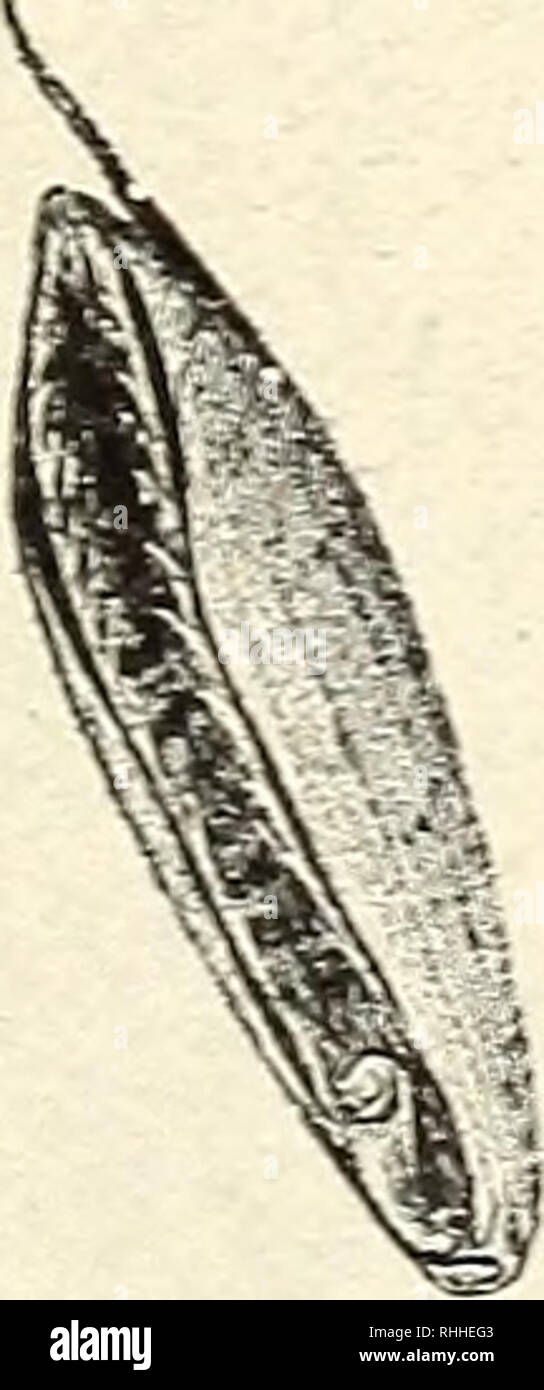 . The bobwhite and other quails of the United States in their economic relations. Quails; Northern bobwhite. FOOD HABITS. 55 secalinus (fig. 10) and Bromus hofdeaceus), a serious grain pest, are relished, and hundreds of the grain-like seeds of the grass known as 'poison darnel* {Lolium temulentum) appear in crops examined. Macoun, quoting Spreadborough, states that in British Columbia, where it winters successfully, the quail finds shelter in severe weather under the broom {Gytisus scoparius), which in places grows abun- dantly and yields seed for subsistence.'1 The quail feeds also at times Stock Photohttps://www.alamy.com/image-license-details/?v=1https://www.alamy.com/the-bobwhite-and-other-quails-of-the-united-states-in-their-economic-relations-quails-northern-bobwhite-food-habits-55-secalinus-fig-10-and-bromus-hofdeaceus-a-serious-grain-pest-are-relished-and-hundreds-of-the-grain-like-seeds-of-the-grass-known-as-poison-darnel-lolium-temulentum-appear-in-crops-examined-macoun-quoting-spreadborough-states-that-in-british-columbia-where-it-winters-successfully-the-quail-finds-shelter-in-severe-weather-under-the-broom-gytisus-scoparius-which-in-places-grows-abun-dantly-and-yields-seed-for-subsistence1-the-quail-feeds-also-at-times-image234568547.html
. The bobwhite and other quails of the United States in their economic relations. Quails; Northern bobwhite. FOOD HABITS. 55 secalinus (fig. 10) and Bromus hofdeaceus), a serious grain pest, are relished, and hundreds of the grain-like seeds of the grass known as 'poison darnel* {Lolium temulentum) appear in crops examined. Macoun, quoting Spreadborough, states that in British Columbia, where it winters successfully, the quail finds shelter in severe weather under the broom {Gytisus scoparius), which in places grows abun- dantly and yields seed for subsistence.'1 The quail feeds also at times Stock Photohttps://www.alamy.com/image-license-details/?v=1https://www.alamy.com/the-bobwhite-and-other-quails-of-the-united-states-in-their-economic-relations-quails-northern-bobwhite-food-habits-55-secalinus-fig-10-and-bromus-hofdeaceus-a-serious-grain-pest-are-relished-and-hundreds-of-the-grain-like-seeds-of-the-grass-known-as-poison-darnel-lolium-temulentum-appear-in-crops-examined-macoun-quoting-spreadborough-states-that-in-british-columbia-where-it-winters-successfully-the-quail-finds-shelter-in-severe-weather-under-the-broom-gytisus-scoparius-which-in-places-grows-abun-dantly-and-yields-seed-for-subsistence1-the-quail-feeds-also-at-times-image234568547.htmlRMRHHEG3–. The bobwhite and other quails of the United States in their economic relations. Quails; Northern bobwhite. FOOD HABITS. 55 secalinus (fig. 10) and Bromus hofdeaceus), a serious grain pest, are relished, and hundreds of the grain-like seeds of the grass known as 'poison darnel* {Lolium temulentum) appear in crops examined. Macoun, quoting Spreadborough, states that in British Columbia, where it winters successfully, the quail finds shelter in severe weather under the broom {Gytisus scoparius), which in places grows abun- dantly and yields seed for subsistence.'1 The quail feeds also at times
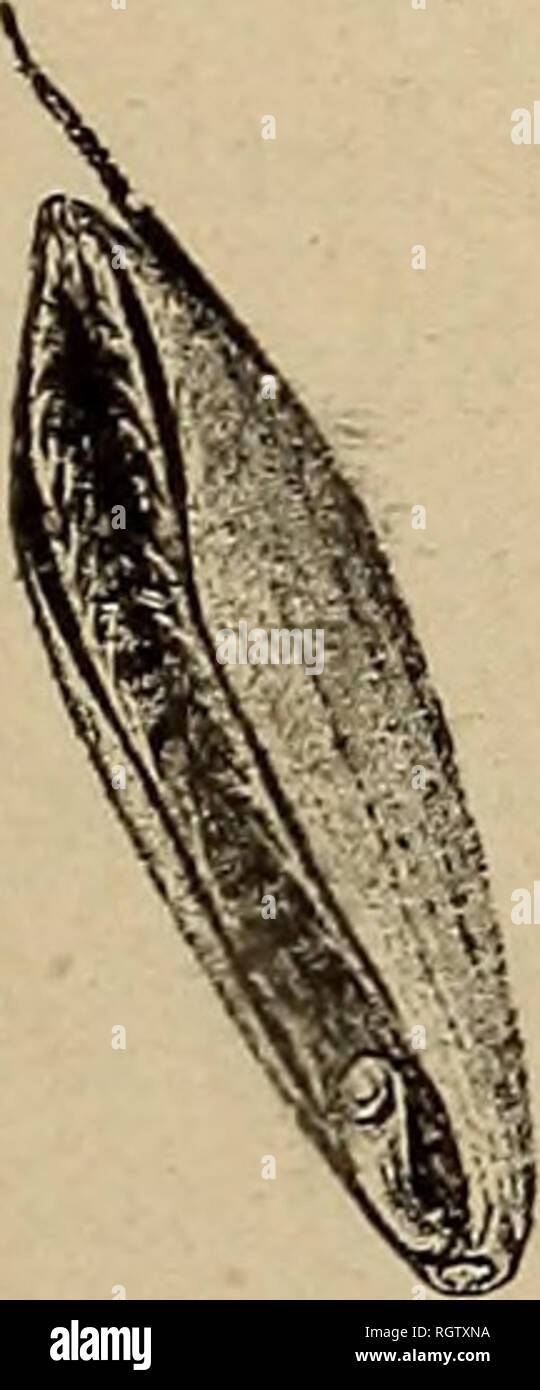 . Bulletin - Biological Survey. Zoology, Economic. FOOD HABITS. 55 secalinus (fig. 10) and Bromus hordeaceus), a serious grain pest, are relished, and hundreds of the grain-like seeds of the grass known as ' poison darnel' (Lolium temulentum) appear in crops examined. Macoun, quoting Spreadborough, states that in British Columbia, where it winters successfully, the quail finds shelter in severe weather under the broom (Cytisus scoparius), which in places grows abun- dantly and yields seed for subsistence^ The quail feeds also at times on mast. A. K. Fisher, in the western foothills of the Sier Stock Photohttps://www.alamy.com/image-license-details/?v=1https://www.alamy.com/bulletin-biological-survey-zoology-economic-food-habits-55-secalinus-fig-10-and-bromus-hordeaceus-a-serious-grain-pest-are-relished-and-hundreds-of-the-grain-like-seeds-of-the-grass-known-as-poison-darnel-lolium-temulentum-appear-in-crops-examined-macoun-quoting-spreadborough-states-that-in-british-columbia-where-it-winters-successfully-the-quail-finds-shelter-in-severe-weather-under-the-broom-cytisus-scoparius-which-in-places-grows-abun-dantly-and-yields-seed-for-subsistence-the-quail-feeds-also-at-times-on-mast-a-k-fisher-in-the-western-foothills-of-the-sier-image234117110.html
. Bulletin - Biological Survey. Zoology, Economic. FOOD HABITS. 55 secalinus (fig. 10) and Bromus hordeaceus), a serious grain pest, are relished, and hundreds of the grain-like seeds of the grass known as ' poison darnel' (Lolium temulentum) appear in crops examined. Macoun, quoting Spreadborough, states that in British Columbia, where it winters successfully, the quail finds shelter in severe weather under the broom (Cytisus scoparius), which in places grows abun- dantly and yields seed for subsistence^ The quail feeds also at times on mast. A. K. Fisher, in the western foothills of the Sier Stock Photohttps://www.alamy.com/image-license-details/?v=1https://www.alamy.com/bulletin-biological-survey-zoology-economic-food-habits-55-secalinus-fig-10-and-bromus-hordeaceus-a-serious-grain-pest-are-relished-and-hundreds-of-the-grain-like-seeds-of-the-grass-known-as-poison-darnel-lolium-temulentum-appear-in-crops-examined-macoun-quoting-spreadborough-states-that-in-british-columbia-where-it-winters-successfully-the-quail-finds-shelter-in-severe-weather-under-the-broom-cytisus-scoparius-which-in-places-grows-abun-dantly-and-yields-seed-for-subsistence-the-quail-feeds-also-at-times-on-mast-a-k-fisher-in-the-western-foothills-of-the-sier-image234117110.htmlRMRGTXNA–. Bulletin - Biological Survey. Zoology, Economic. FOOD HABITS. 55 secalinus (fig. 10) and Bromus hordeaceus), a serious grain pest, are relished, and hundreds of the grain-like seeds of the grass known as ' poison darnel' (Lolium temulentum) appear in crops examined. Macoun, quoting Spreadborough, states that in British Columbia, where it winters successfully, the quail finds shelter in severe weather under the broom (Cytisus scoparius), which in places grows abun- dantly and yields seed for subsistence^ The quail feeds also at times on mast. A. K. Fisher, in the western foothills of the Sier
 A companion to the United States pharmacopia; . -—The fruit or grain (caryopsis). Description.—Oblong-ovoid, about five millimeters ( inch) long,smooth, pale brownish, interiorly white, inodorous, having a farinaceous,afterward bitterish taste. Constituents.—Fixed oil, starch, etc. It is not determined whatconstitutes the poisonous principle. Medicinal Uses.—Darnel is a narcotic poison, but has been medi-cinally employed only as an ingredient of poultices to relieve pain, etc. Lotiones. Lotions. These preparations are usually solutions in water, or in water withalcohol or glycerin, and are us Stock Photohttps://www.alamy.com/image-license-details/?v=1https://www.alamy.com/a-companion-to-the-united-states-pharmacopia-the-fruit-or-grain-caryopsis-descriptionoblong-ovoid-about-five-millimeters-inch-longsmooth-pale-brownish-interiorly-white-inodorous-having-a-farinaceousafterward-bitterish-taste-constituentsfixed-oil-starch-etc-it-is-not-determined-whatconstitutes-the-poisonous-principle-medicinal-usesdarnel-is-a-narcotic-poison-but-has-been-medi-cinally-employed-only-as-an-ingredient-of-poultices-to-relieve-pain-etc-lotiones-lotions-these-preparations-are-usually-solutions-in-water-or-in-water-withalcohol-or-glycerin-and-are-us-image339456670.html
A companion to the United States pharmacopia; . -—The fruit or grain (caryopsis). Description.—Oblong-ovoid, about five millimeters ( inch) long,smooth, pale brownish, interiorly white, inodorous, having a farinaceous,afterward bitterish taste. Constituents.—Fixed oil, starch, etc. It is not determined whatconstitutes the poisonous principle. Medicinal Uses.—Darnel is a narcotic poison, but has been medi-cinally employed only as an ingredient of poultices to relieve pain, etc. Lotiones. Lotions. These preparations are usually solutions in water, or in water withalcohol or glycerin, and are us Stock Photohttps://www.alamy.com/image-license-details/?v=1https://www.alamy.com/a-companion-to-the-united-states-pharmacopia-the-fruit-or-grain-caryopsis-descriptionoblong-ovoid-about-five-millimeters-inch-longsmooth-pale-brownish-interiorly-white-inodorous-having-a-farinaceousafterward-bitterish-taste-constituentsfixed-oil-starch-etc-it-is-not-determined-whatconstitutes-the-poisonous-principle-medicinal-usesdarnel-is-a-narcotic-poison-but-has-been-medi-cinally-employed-only-as-an-ingredient-of-poultices-to-relieve-pain-etc-lotiones-lotions-these-preparations-are-usually-solutions-in-water-or-in-water-withalcohol-or-glycerin-and-are-us-image339456670.htmlRM2AM7GCE–A companion to the United States pharmacopia; . -—The fruit or grain (caryopsis). Description.—Oblong-ovoid, about five millimeters ( inch) long,smooth, pale brownish, interiorly white, inodorous, having a farinaceous,afterward bitterish taste. Constituents.—Fixed oil, starch, etc. It is not determined whatconstitutes the poisonous principle. Medicinal Uses.—Darnel is a narcotic poison, but has been medi-cinally employed only as an ingredient of poultices to relieve pain, etc. Lotiones. Lotions. These preparations are usually solutions in water, or in water withalcohol or glycerin, and are us
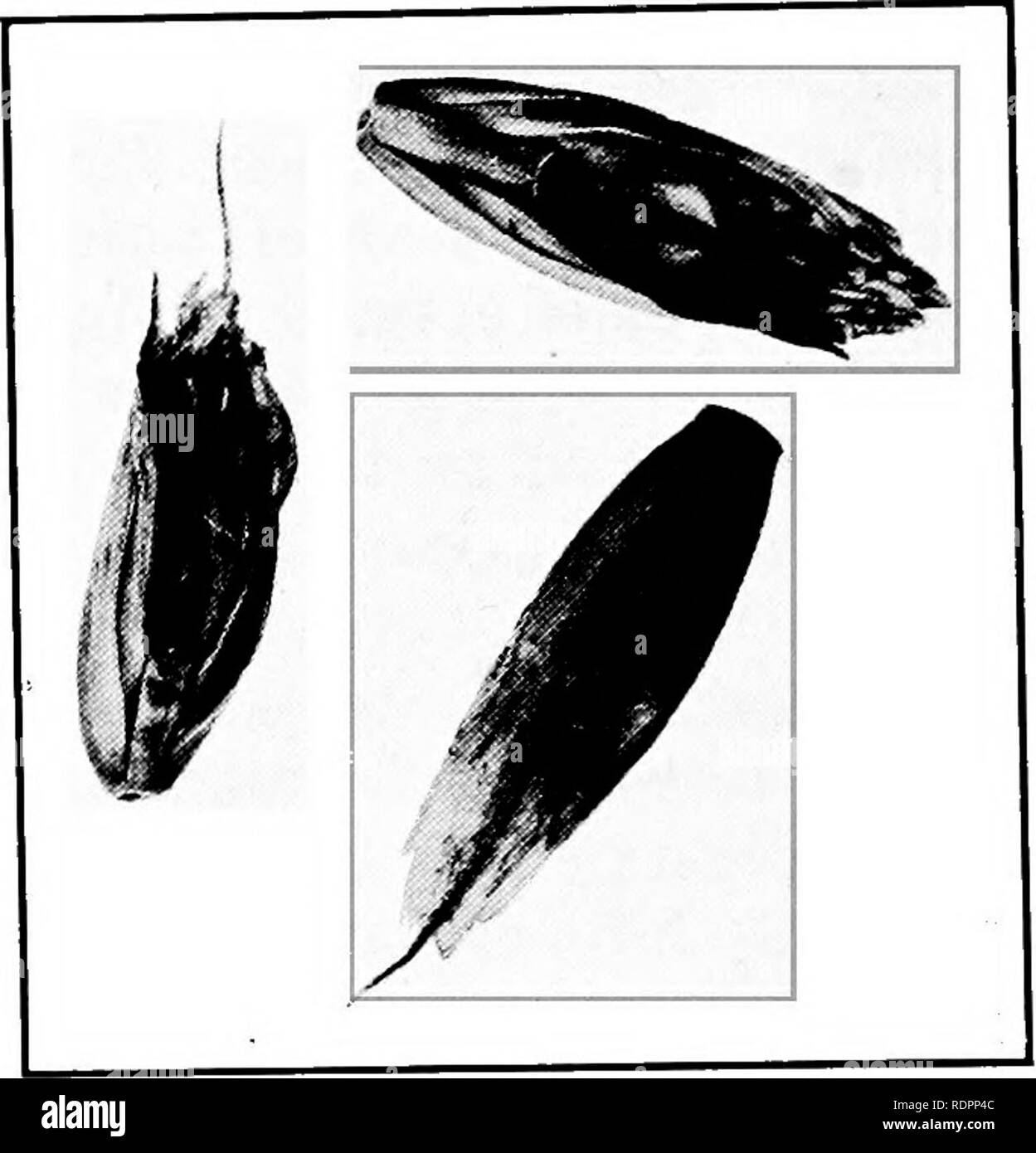 . A guide to the poisonous plants and weed seeds of Canada and the northern United States. Poisonous plants; Botany; Botany. 92 Ground Feeds. its relationship is not known. As the seed sprouts the fungus keeps pace with the growth of the young plant, and finally affects the grain again. Feeding tests which would prove whether the fungus is responsible for the poisoning have not been made.. Fig. 19.—Grains of Darnel—Lolium temulentum. natural size. rive times Symptoms The symptoms are those of a deliriant nerve poison. There is confusion of sight which was known in very early times and is menti Stock Photohttps://www.alamy.com/image-license-details/?v=1https://www.alamy.com/a-guide-to-the-poisonous-plants-and-weed-seeds-of-canada-and-the-northern-united-states-poisonous-plants-botany-botany-92-ground-feeds-its-relationship-is-not-known-as-the-seed-sprouts-the-fungus-keeps-pace-with-the-growth-of-the-young-plant-and-finally-affects-the-grain-again-feeding-tests-which-would-prove-whether-the-fungus-is-responsible-for-the-poisoning-have-not-been-made-fig-19grains-of-darnellolium-temulentum-natural-size-rive-times-symptoms-the-symptoms-are-those-of-a-deliriant-nerve-poison-there-is-confusion-of-sight-which-was-known-in-very-early-times-and-is-menti-image232225628.html
. A guide to the poisonous plants and weed seeds of Canada and the northern United States. Poisonous plants; Botany; Botany. 92 Ground Feeds. its relationship is not known. As the seed sprouts the fungus keeps pace with the growth of the young plant, and finally affects the grain again. Feeding tests which would prove whether the fungus is responsible for the poisoning have not been made.. Fig. 19.—Grains of Darnel—Lolium temulentum. natural size. rive times Symptoms The symptoms are those of a deliriant nerve poison. There is confusion of sight which was known in very early times and is menti Stock Photohttps://www.alamy.com/image-license-details/?v=1https://www.alamy.com/a-guide-to-the-poisonous-plants-and-weed-seeds-of-canada-and-the-northern-united-states-poisonous-plants-botany-botany-92-ground-feeds-its-relationship-is-not-known-as-the-seed-sprouts-the-fungus-keeps-pace-with-the-growth-of-the-young-plant-and-finally-affects-the-grain-again-feeding-tests-which-would-prove-whether-the-fungus-is-responsible-for-the-poisoning-have-not-been-made-fig-19grains-of-darnellolium-temulentum-natural-size-rive-times-symptoms-the-symptoms-are-those-of-a-deliriant-nerve-poison-there-is-confusion-of-sight-which-was-known-in-very-early-times-and-is-menti-image232225628.htmlRMRDPP4C–. A guide to the poisonous plants and weed seeds of Canada and the northern United States. Poisonous plants; Botany; Botany. 92 Ground Feeds. its relationship is not known. As the seed sprouts the fungus keeps pace with the growth of the young plant, and finally affects the grain again. Feeding tests which would prove whether the fungus is responsible for the poisoning have not been made.. Fig. 19.—Grains of Darnel—Lolium temulentum. natural size. rive times Symptoms The symptoms are those of a deliriant nerve poison. There is confusion of sight which was known in very early times and is menti
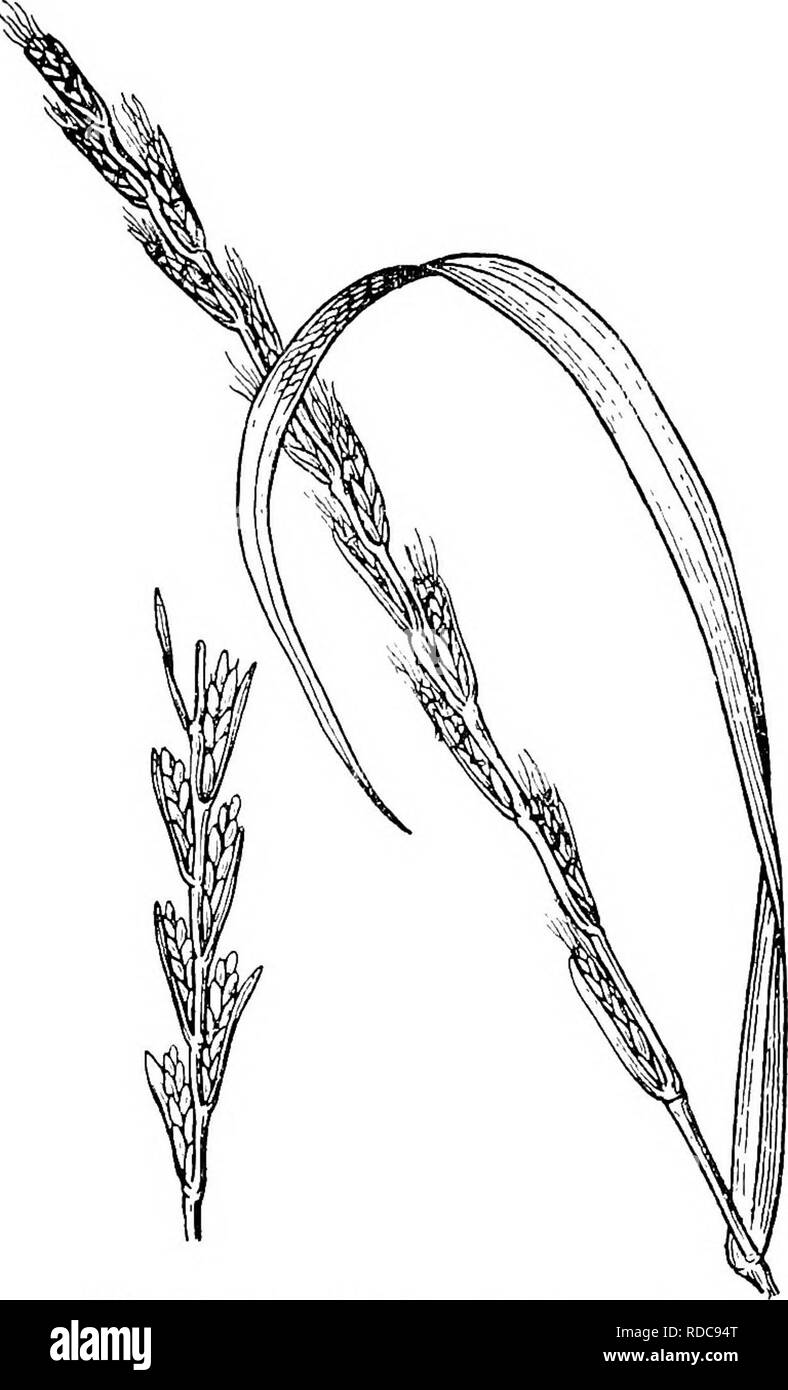 . A manual of veterinary hygiene. Veterinary hygiene. 186 VETEKINAEY HYGIENE who found that Lolium was only poisonous to horses in con- siderable doses, two to six pounds, more than is ever likely to be obtained by ordinary grazing or in hay. The poison is known as Temuline and is said not to affect oxen, but poisons other animals, including man. It produces vertigo, and symptoms of loss of co-ordination.. Fig. 49.—Darnel {Lolium temulentum). These are not the only poisonous grasses. Bromus catharticus is a purgative, Festuca quadrivalvis, a grass grow- ing in Peru, and the Molinia ccerulea, a Stock Photohttps://www.alamy.com/image-license-details/?v=1https://www.alamy.com/a-manual-of-veterinary-hygiene-veterinary-hygiene-186-vetekinaey-hygiene-who-found-that-lolium-was-only-poisonous-to-horses-in-con-siderable-doses-two-to-six-pounds-more-than-is-ever-likely-to-be-obtained-by-ordinary-grazing-or-in-hay-the-poison-is-known-as-temuline-and-is-said-not-to-affect-oxen-but-poisons-other-animals-including-man-it-produces-vertigo-and-symptoms-of-loss-of-co-ordination-fig-49darnel-lolium-temulentum-these-are-not-the-only-poisonous-grasses-bromus-catharticus-is-a-purgative-festuca-quadrivalvis-a-grass-grow-ing-in-peru-and-the-molinia-ccerulea-a-image231995928.html
. A manual of veterinary hygiene. Veterinary hygiene. 186 VETEKINAEY HYGIENE who found that Lolium was only poisonous to horses in con- siderable doses, two to six pounds, more than is ever likely to be obtained by ordinary grazing or in hay. The poison is known as Temuline and is said not to affect oxen, but poisons other animals, including man. It produces vertigo, and symptoms of loss of co-ordination.. Fig. 49.—Darnel {Lolium temulentum). These are not the only poisonous grasses. Bromus catharticus is a purgative, Festuca quadrivalvis, a grass grow- ing in Peru, and the Molinia ccerulea, a Stock Photohttps://www.alamy.com/image-license-details/?v=1https://www.alamy.com/a-manual-of-veterinary-hygiene-veterinary-hygiene-186-vetekinaey-hygiene-who-found-that-lolium-was-only-poisonous-to-horses-in-con-siderable-doses-two-to-six-pounds-more-than-is-ever-likely-to-be-obtained-by-ordinary-grazing-or-in-hay-the-poison-is-known-as-temuline-and-is-said-not-to-affect-oxen-but-poisons-other-animals-including-man-it-produces-vertigo-and-symptoms-of-loss-of-co-ordination-fig-49darnel-lolium-temulentum-these-are-not-the-only-poisonous-grasses-bromus-catharticus-is-a-purgative-festuca-quadrivalvis-a-grass-grow-ing-in-peru-and-the-molinia-ccerulea-a-image231995928.htmlRMRDC94T–. A manual of veterinary hygiene. Veterinary hygiene. 186 VETEKINAEY HYGIENE who found that Lolium was only poisonous to horses in con- siderable doses, two to six pounds, more than is ever likely to be obtained by ordinary grazing or in hay. The poison is known as Temuline and is said not to affect oxen, but poisons other animals, including man. It produces vertigo, and symptoms of loss of co-ordination.. Fig. 49.—Darnel {Lolium temulentum). These are not the only poisonous grasses. Bromus catharticus is a purgative, Festuca quadrivalvis, a grass grow- ing in Peru, and the Molinia ccerulea, a